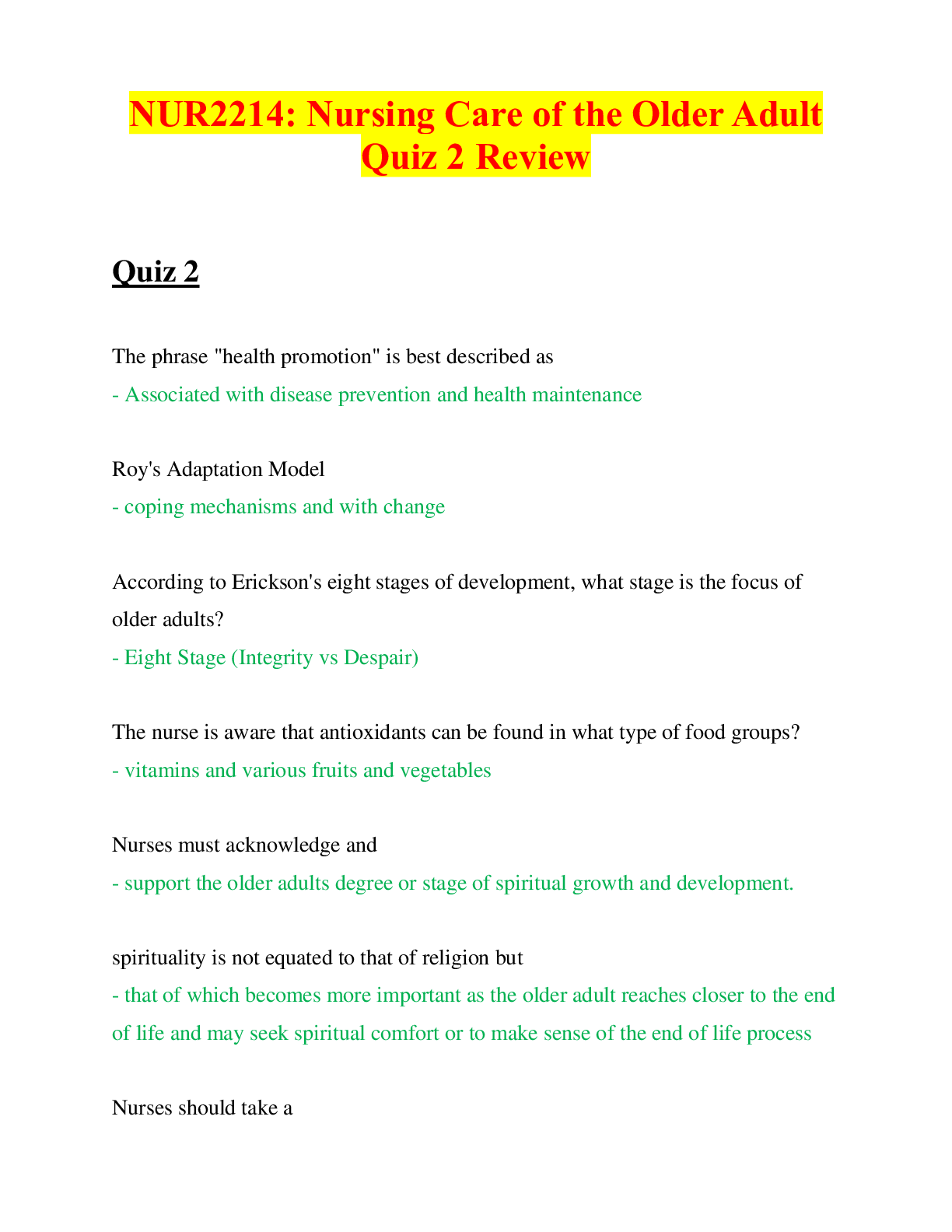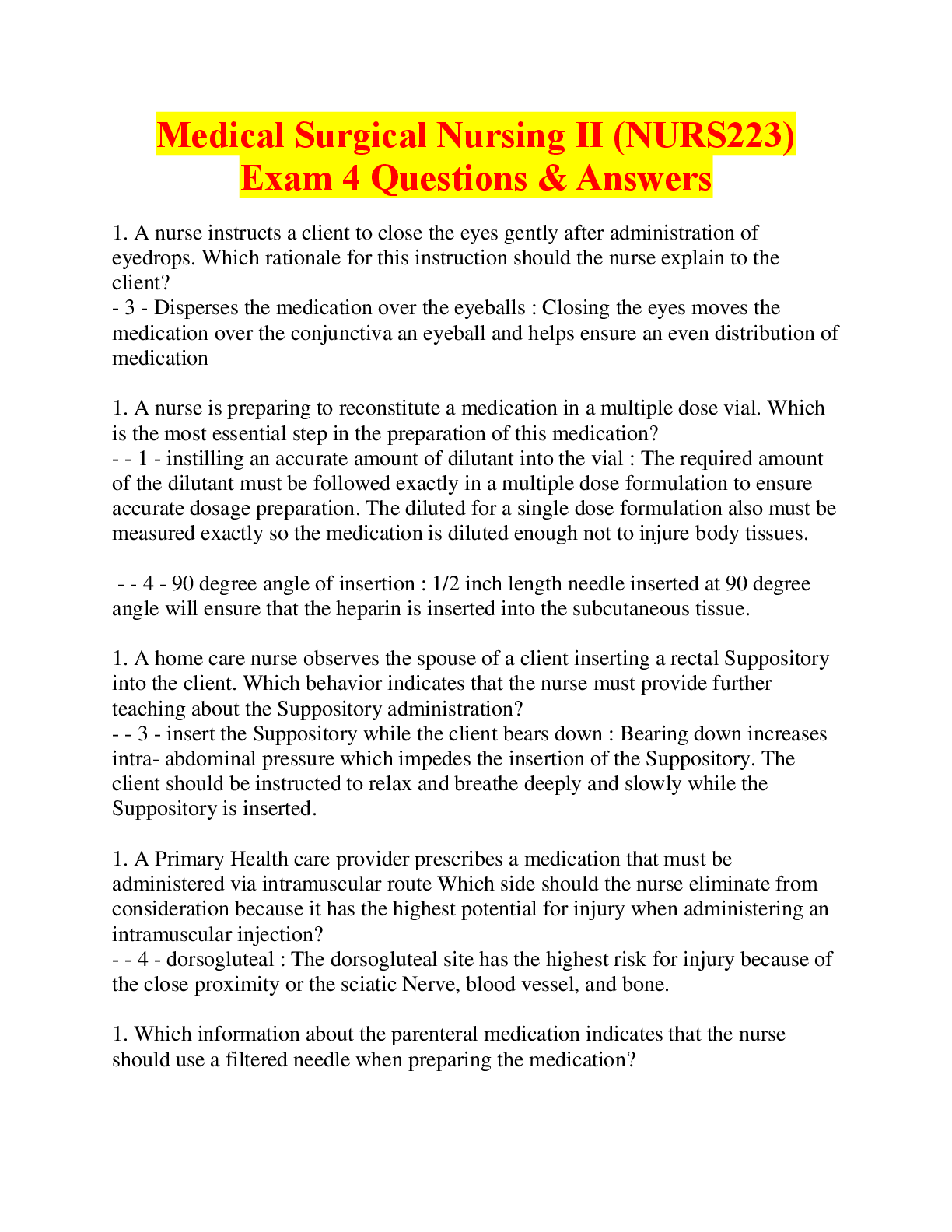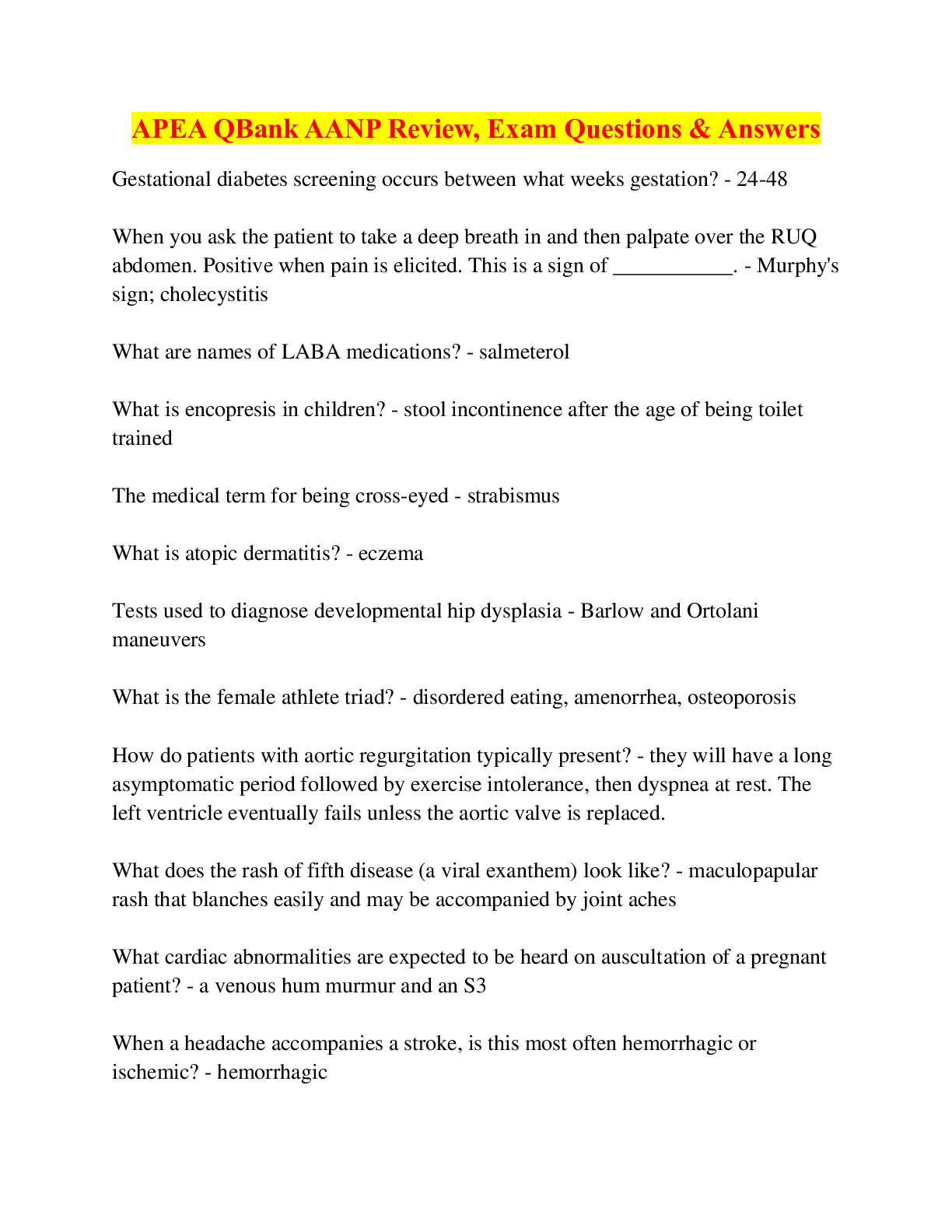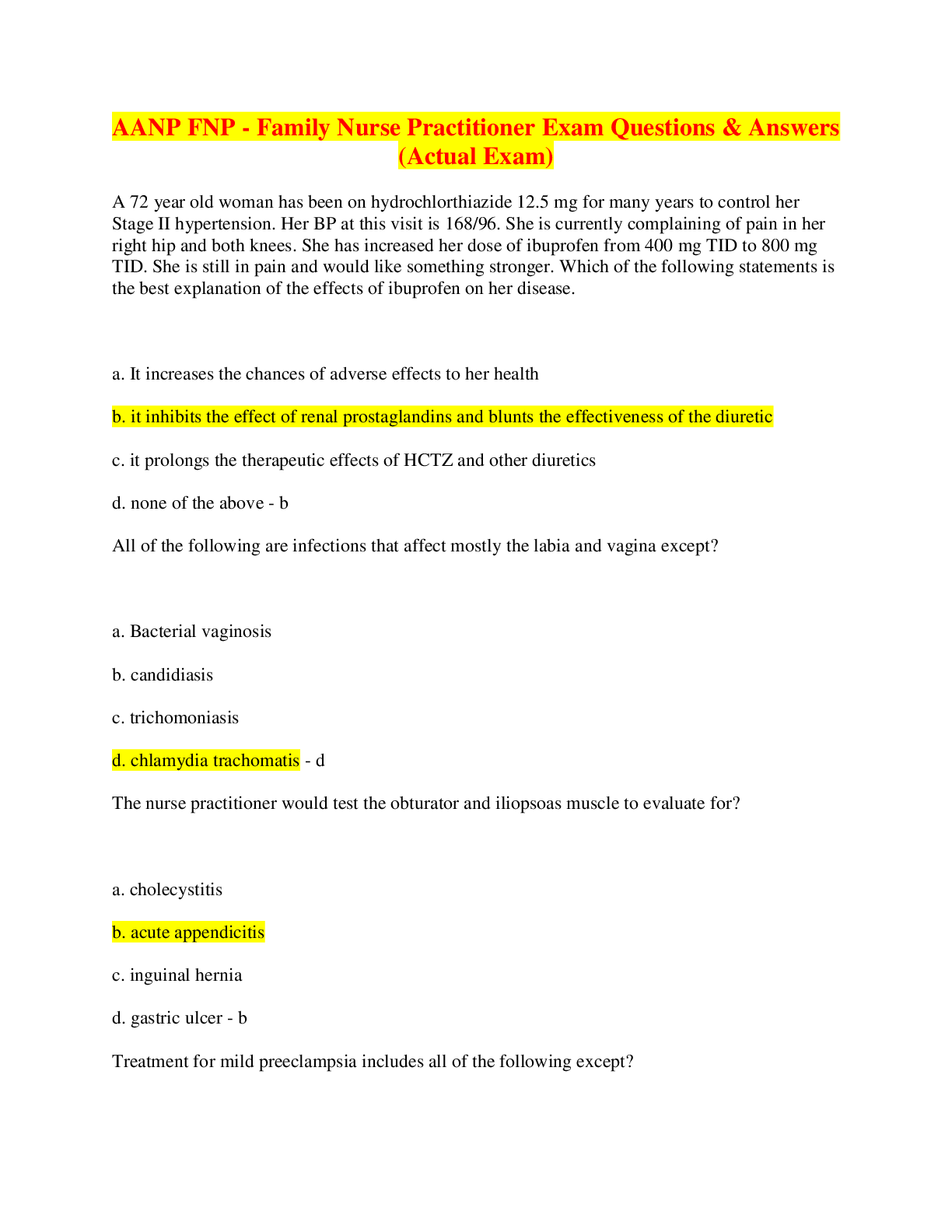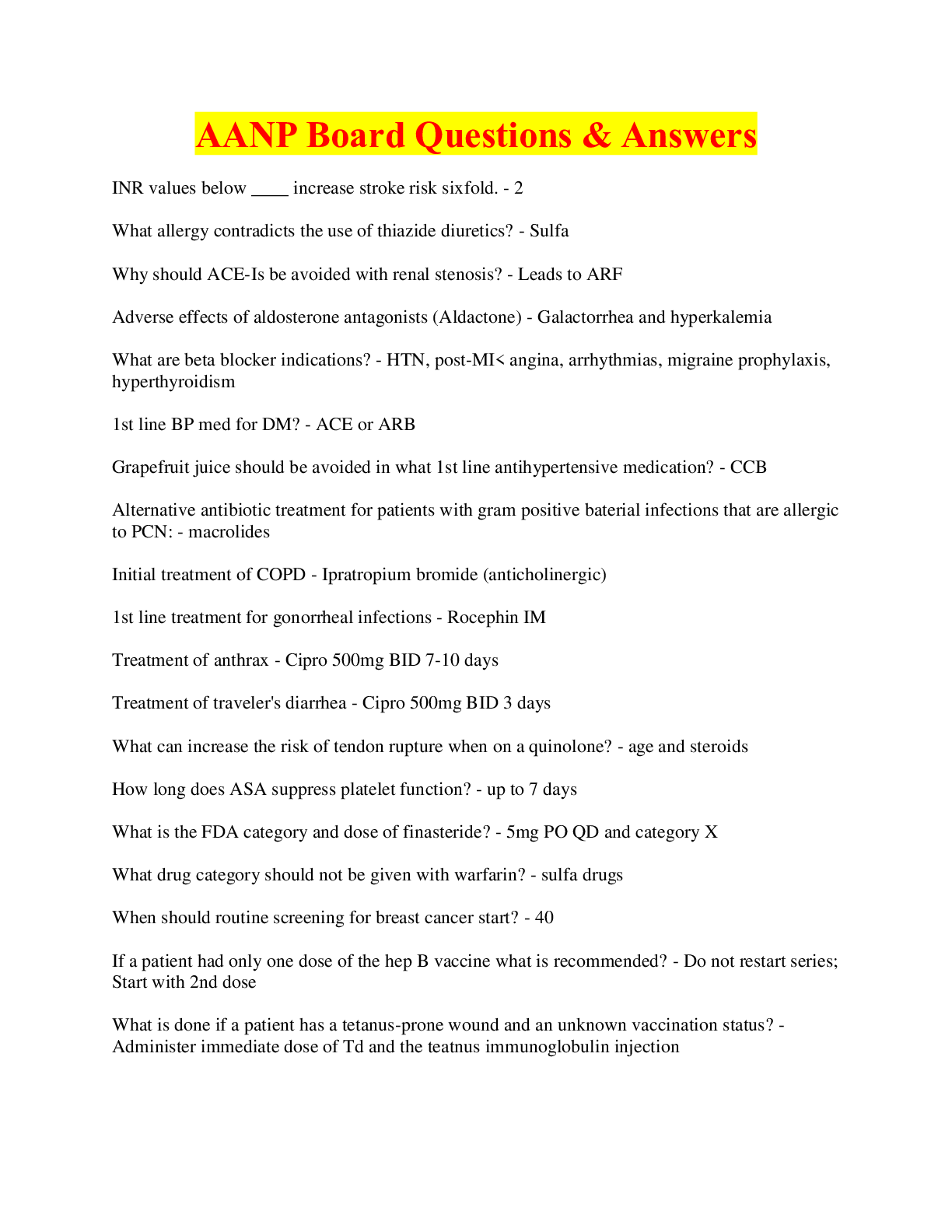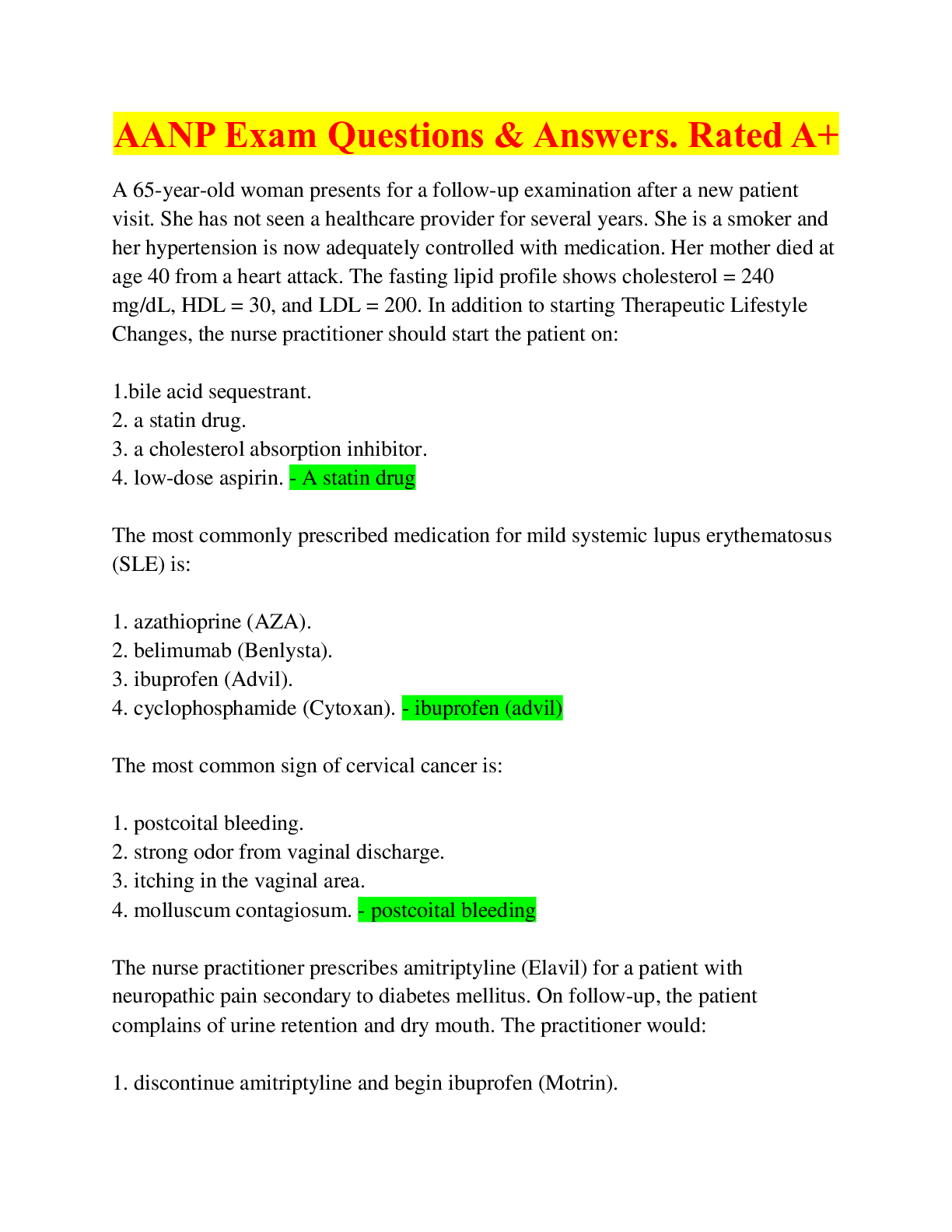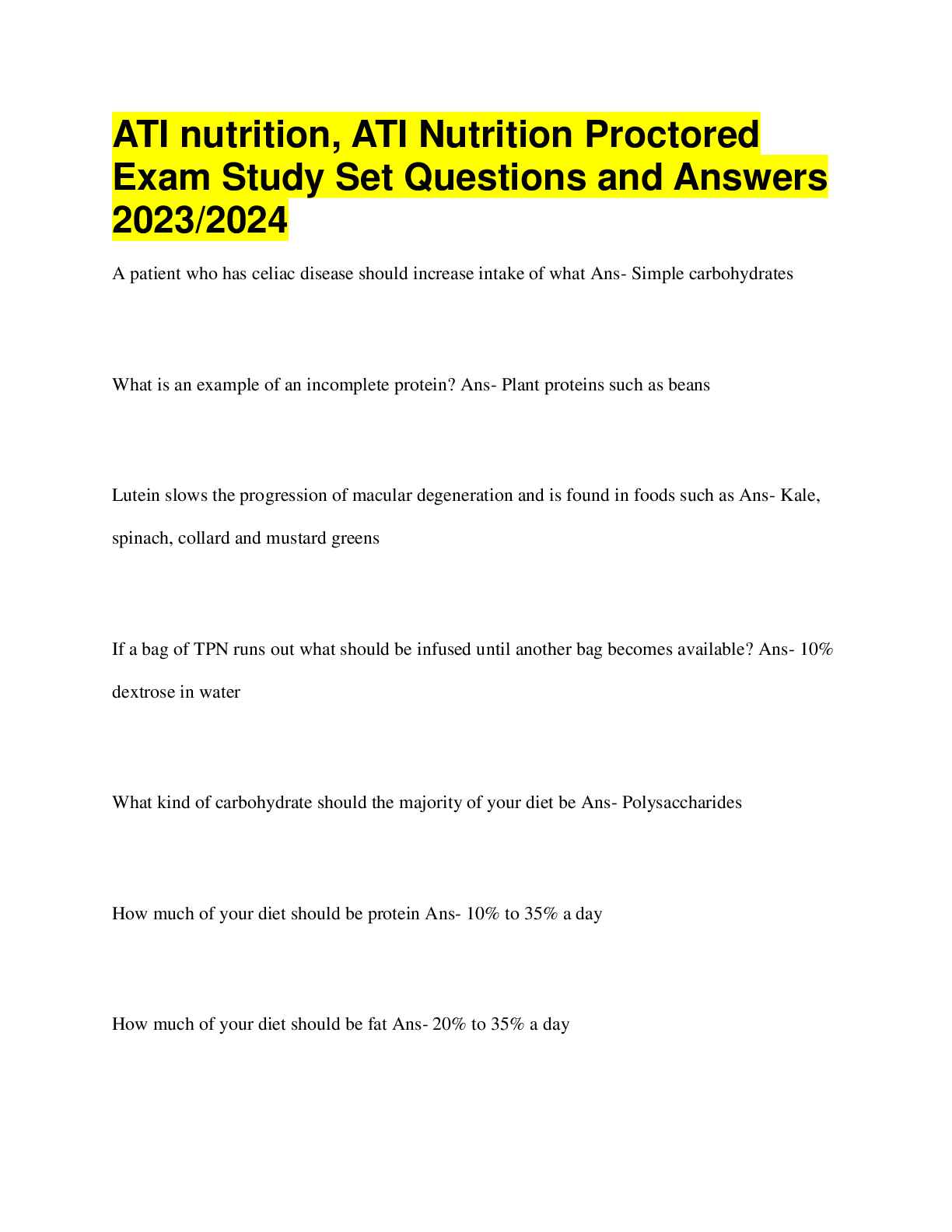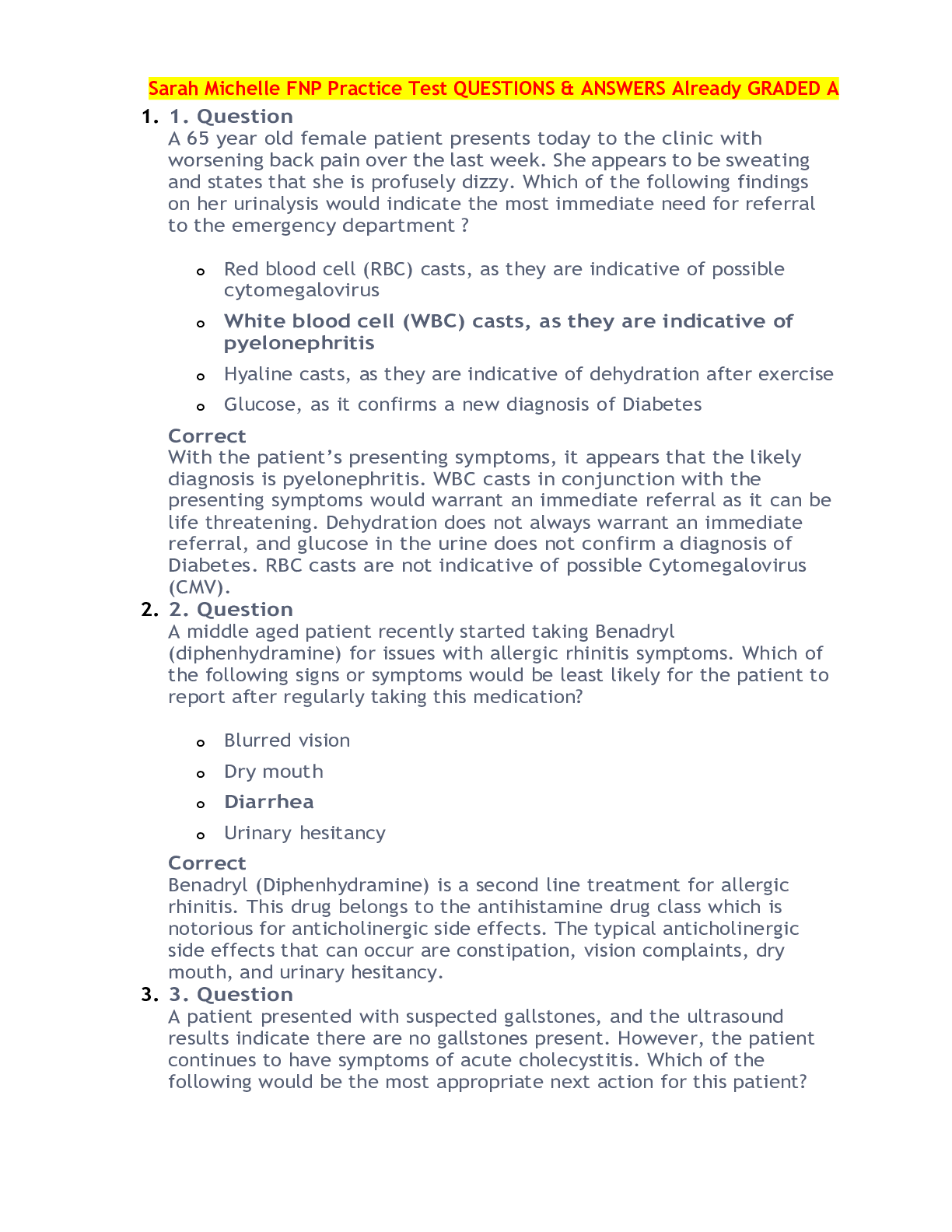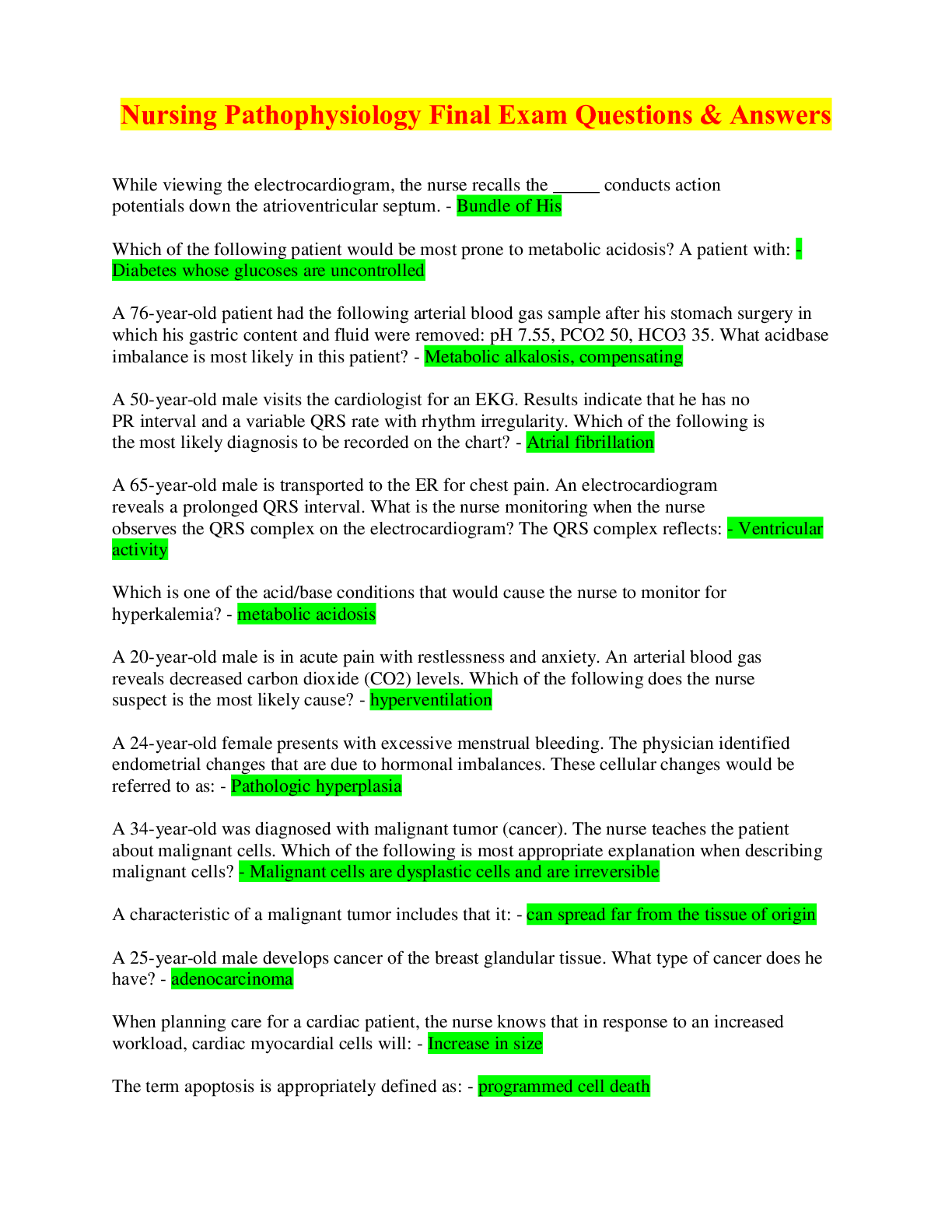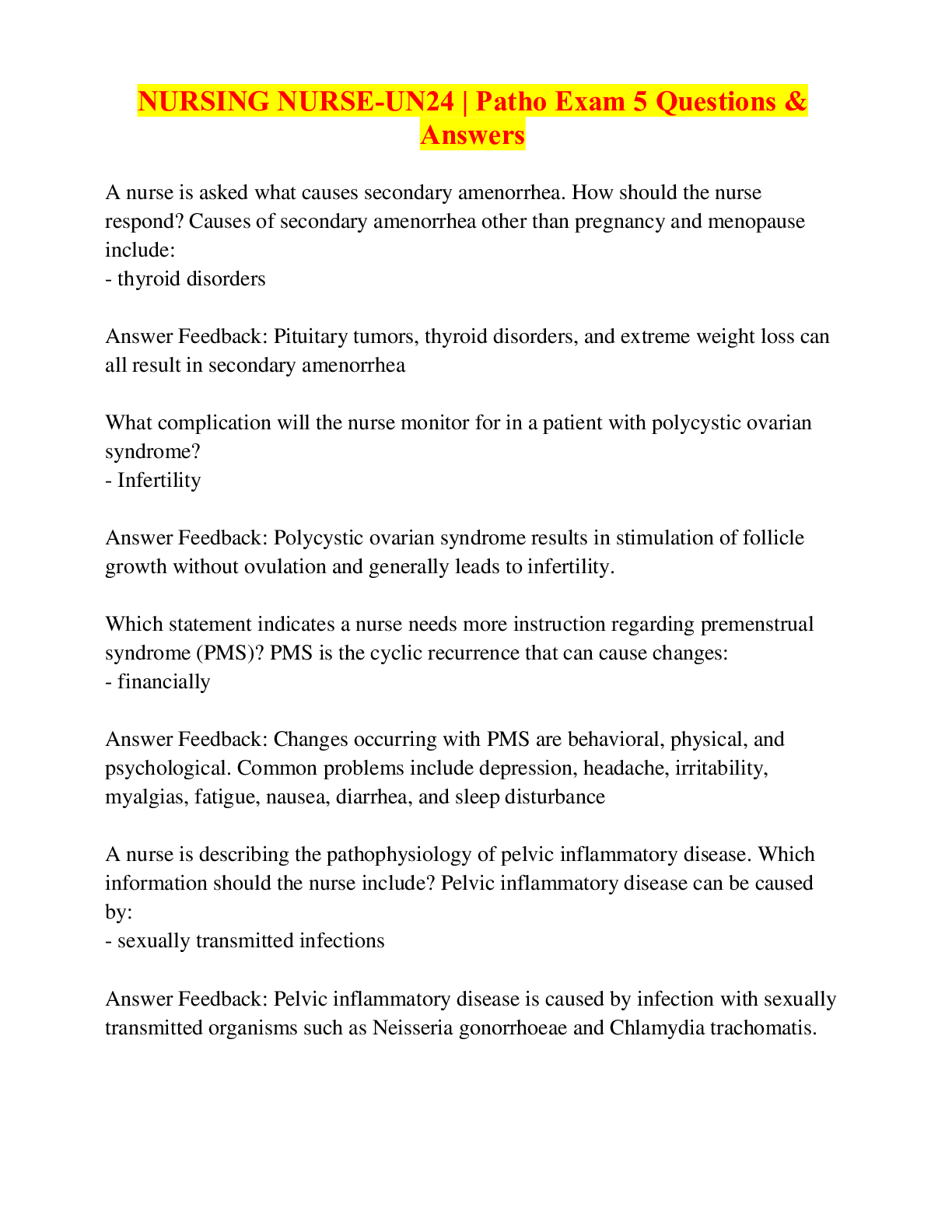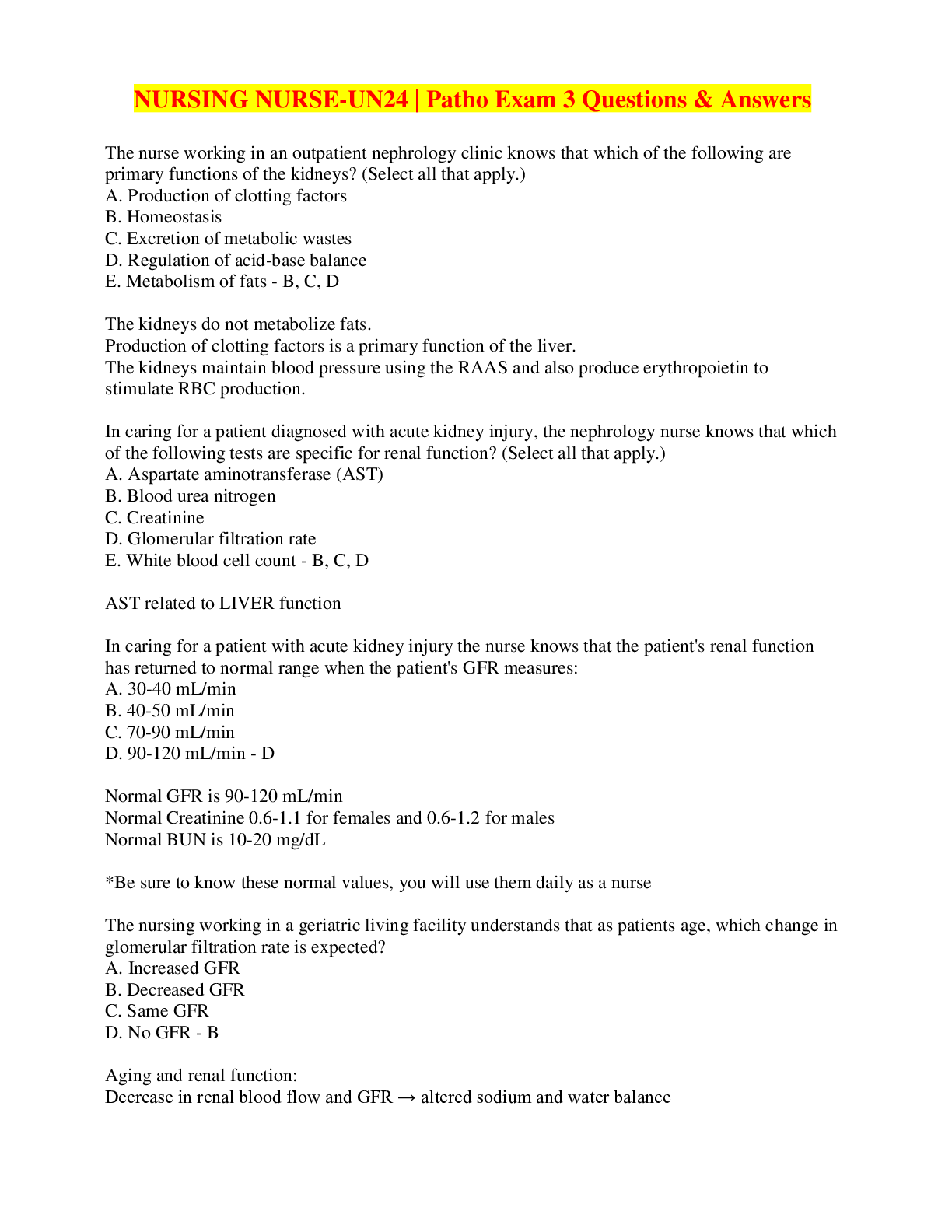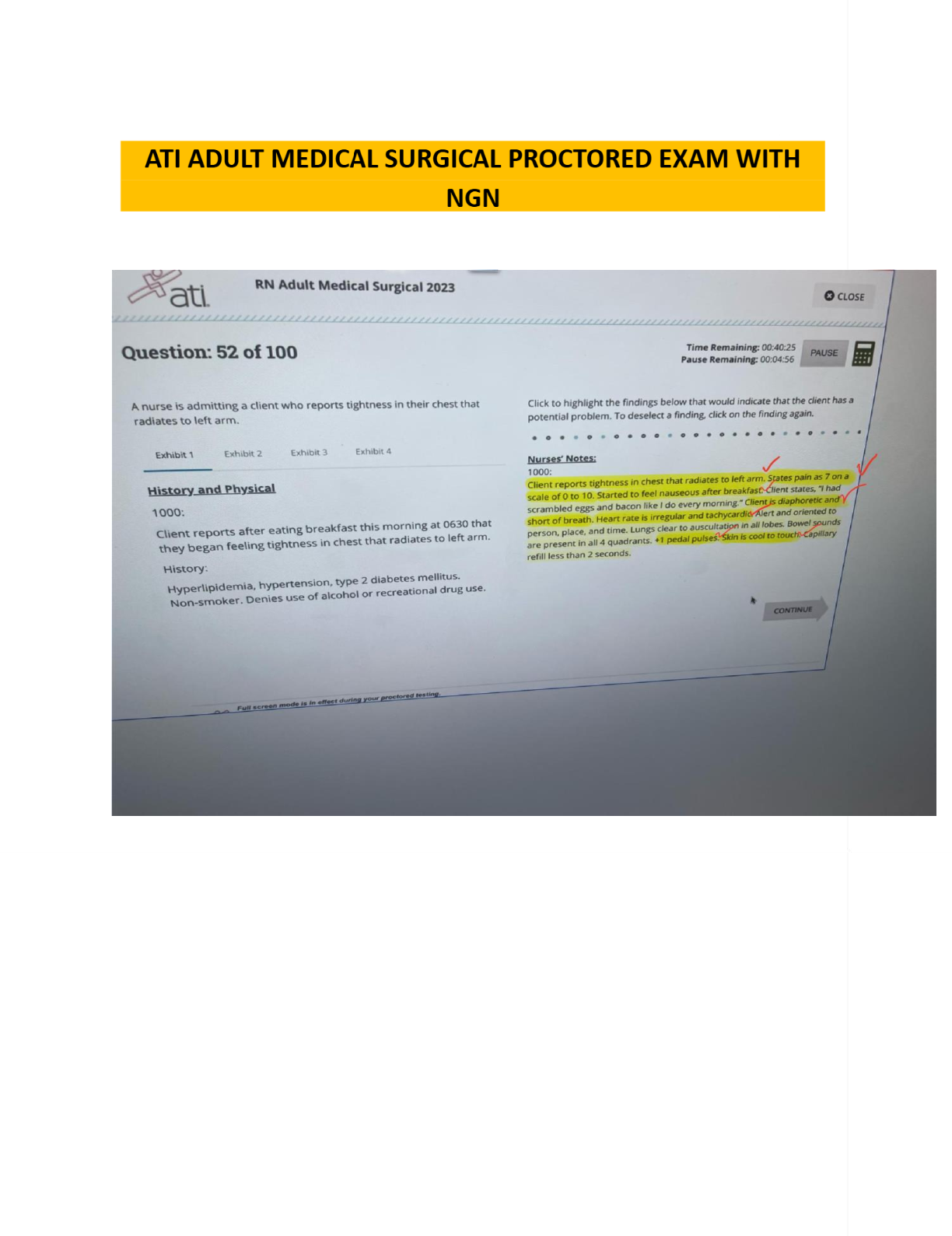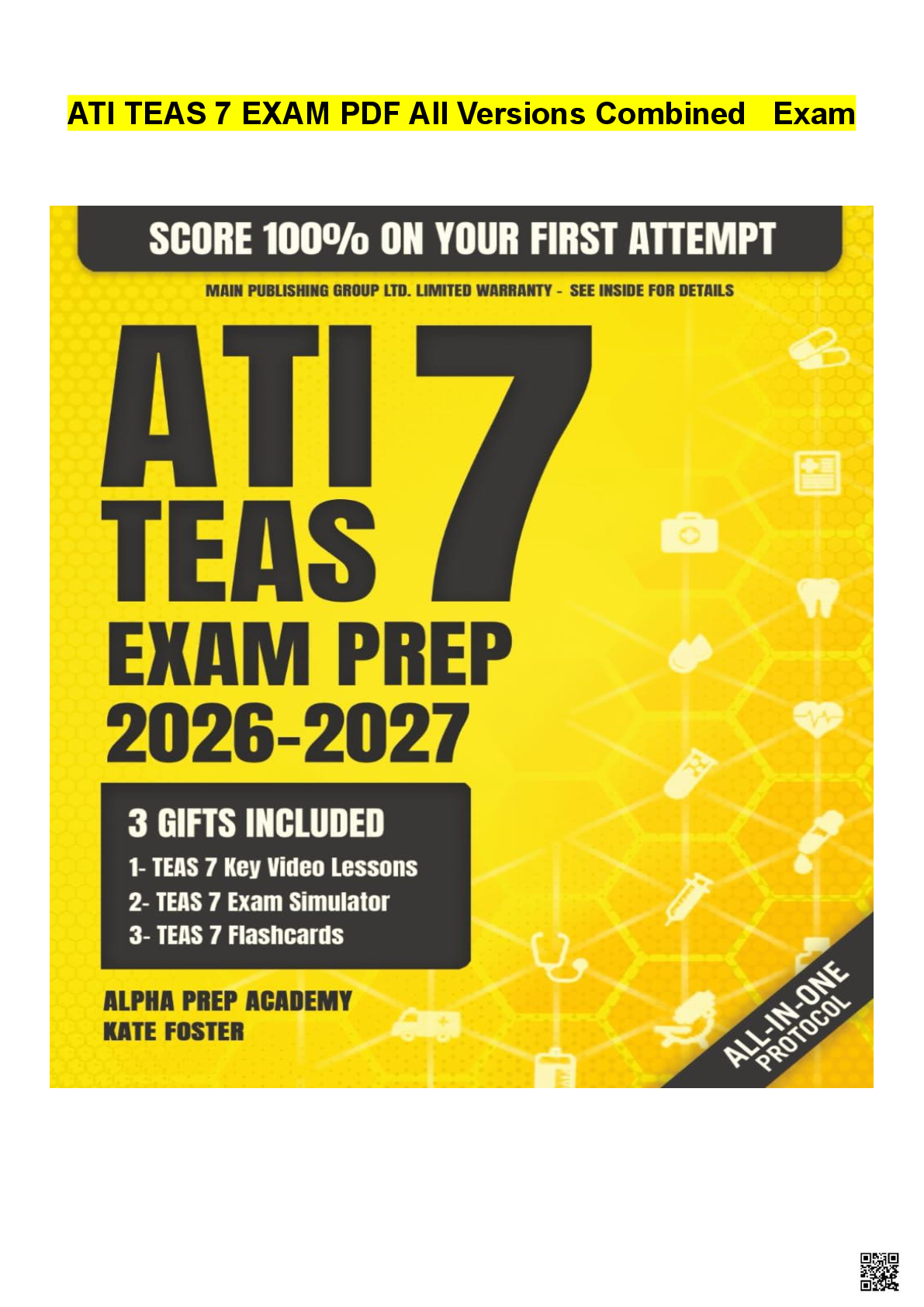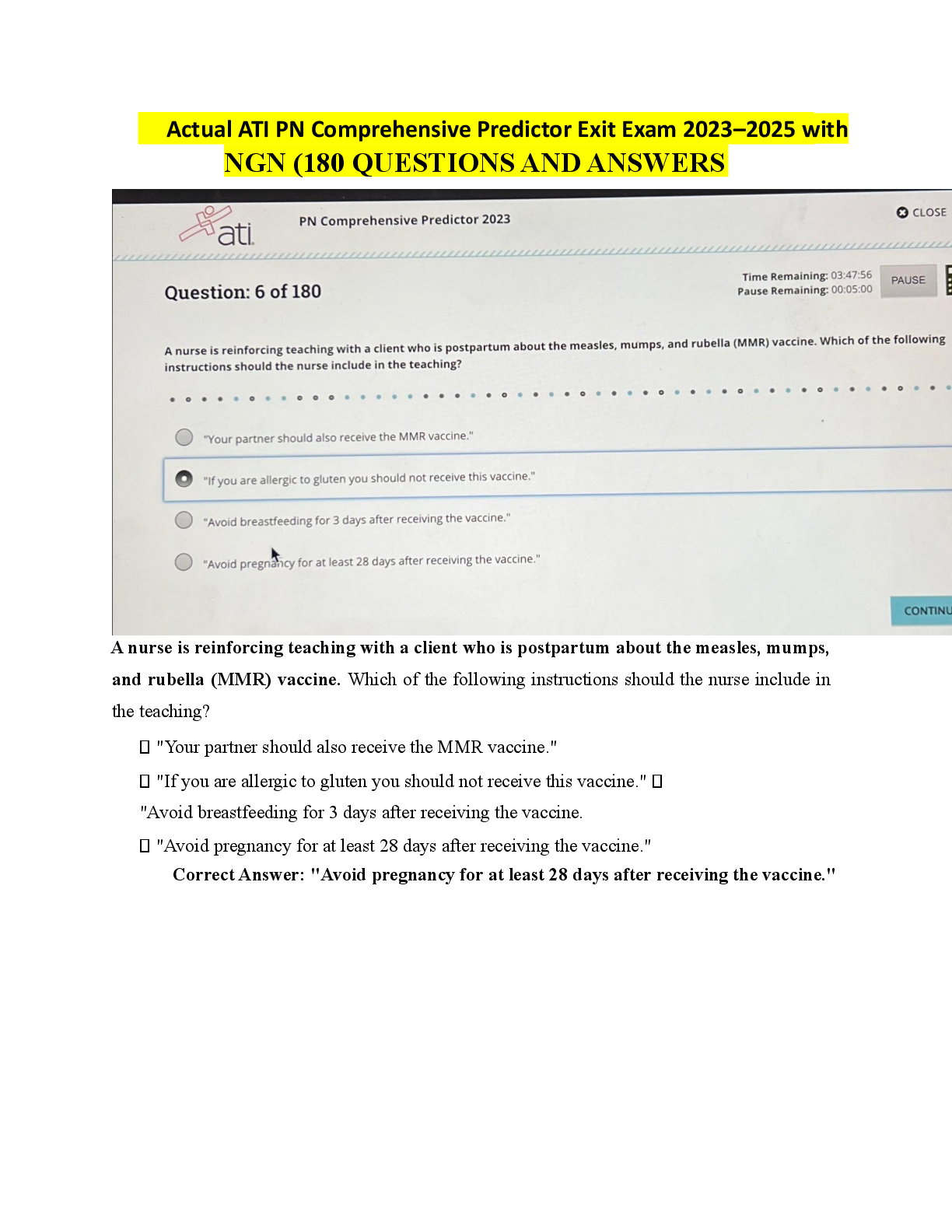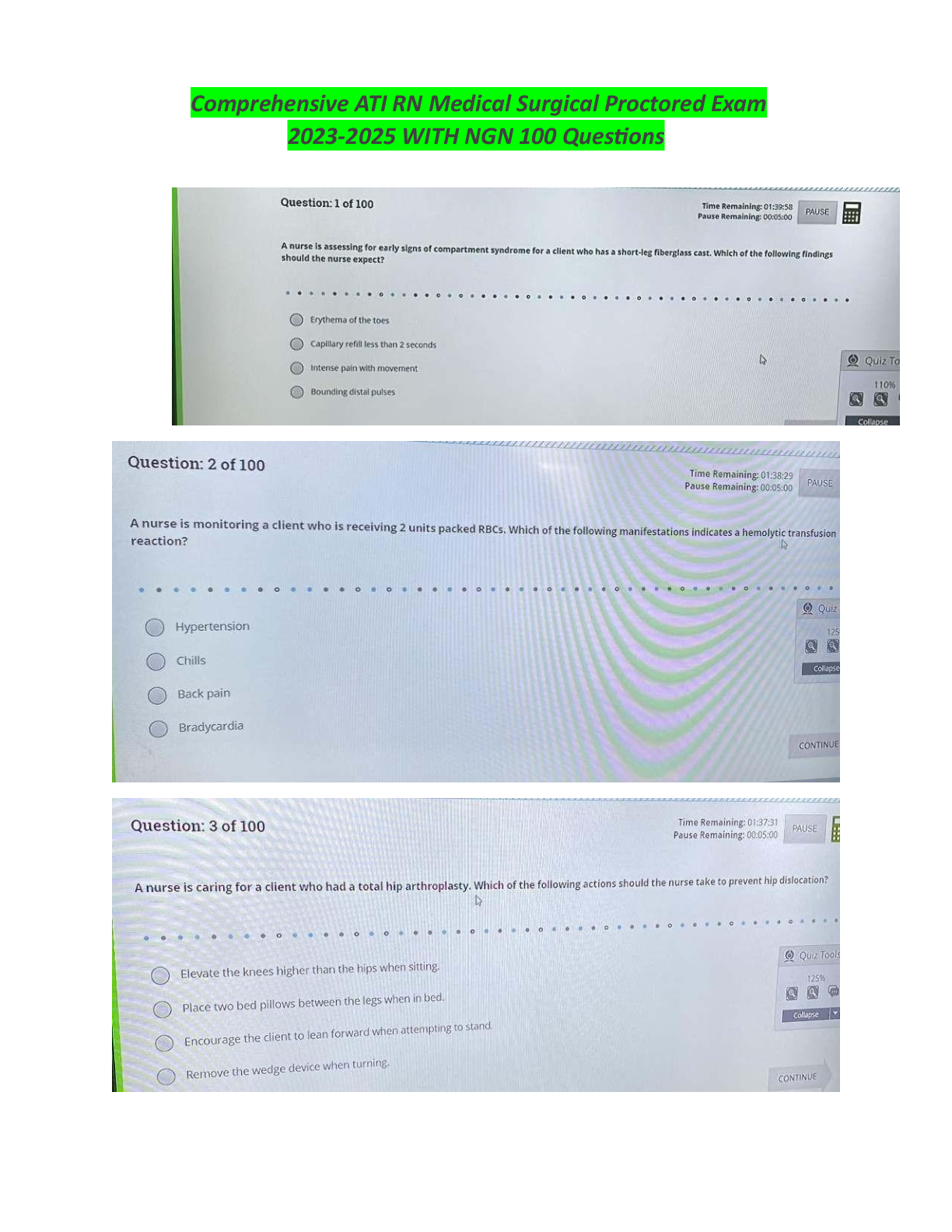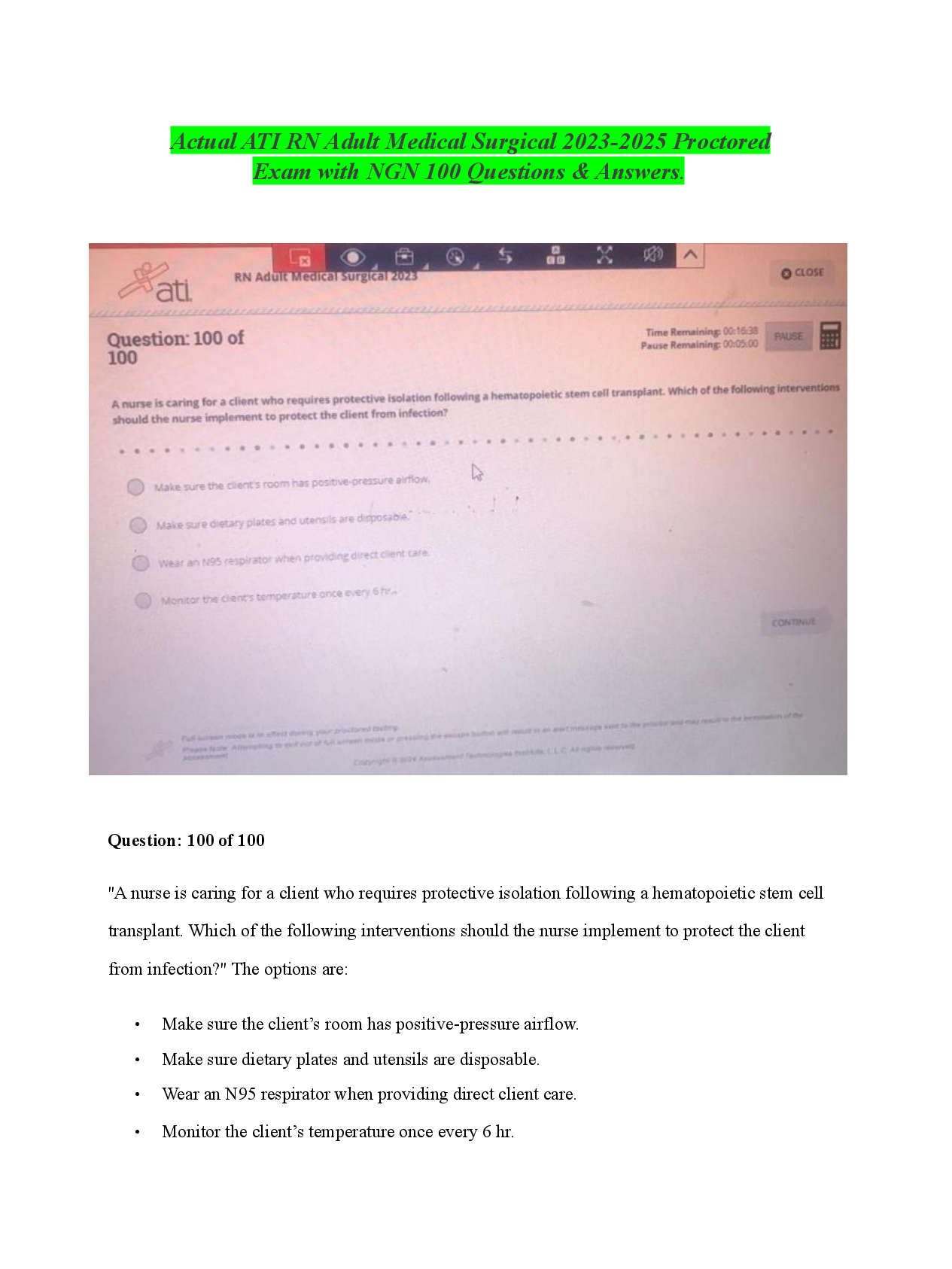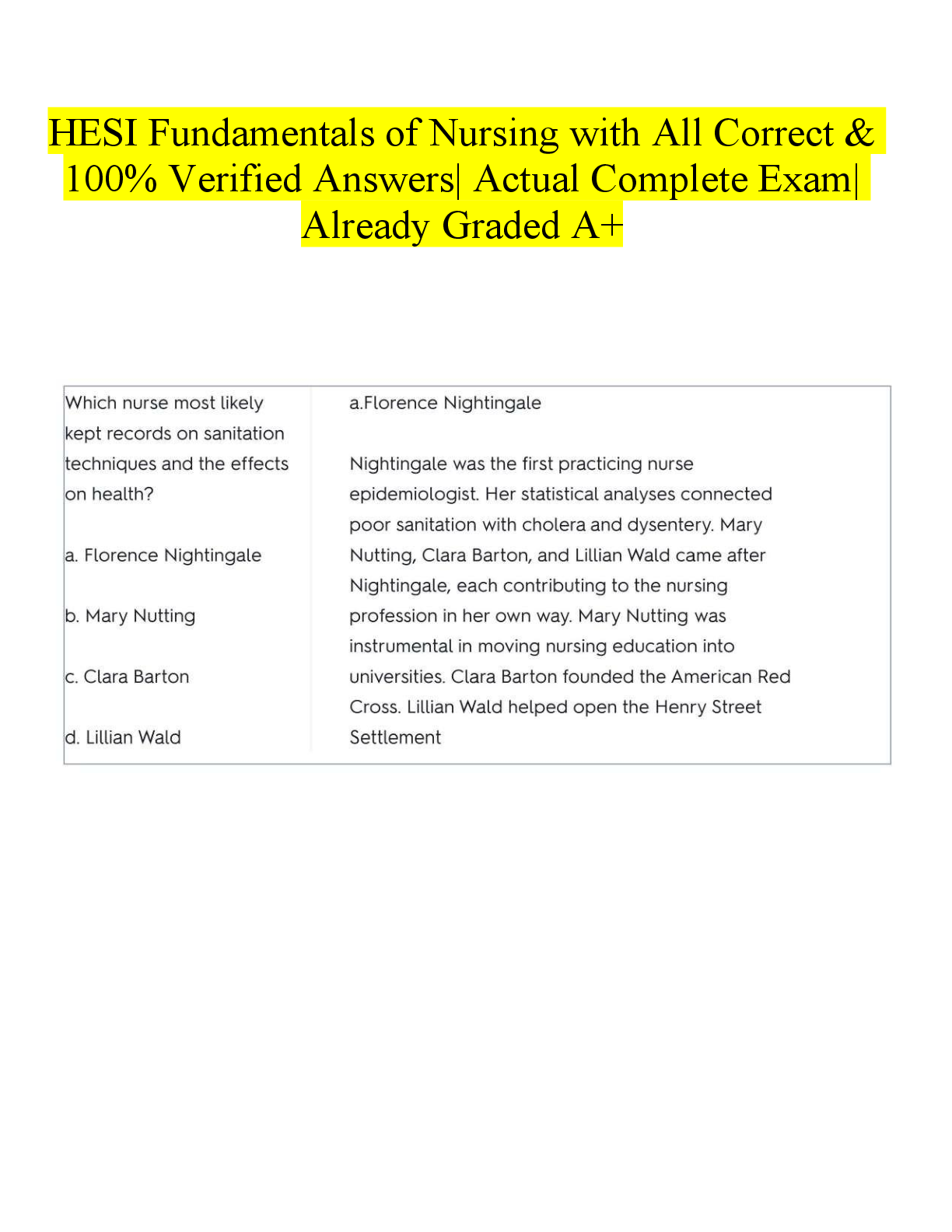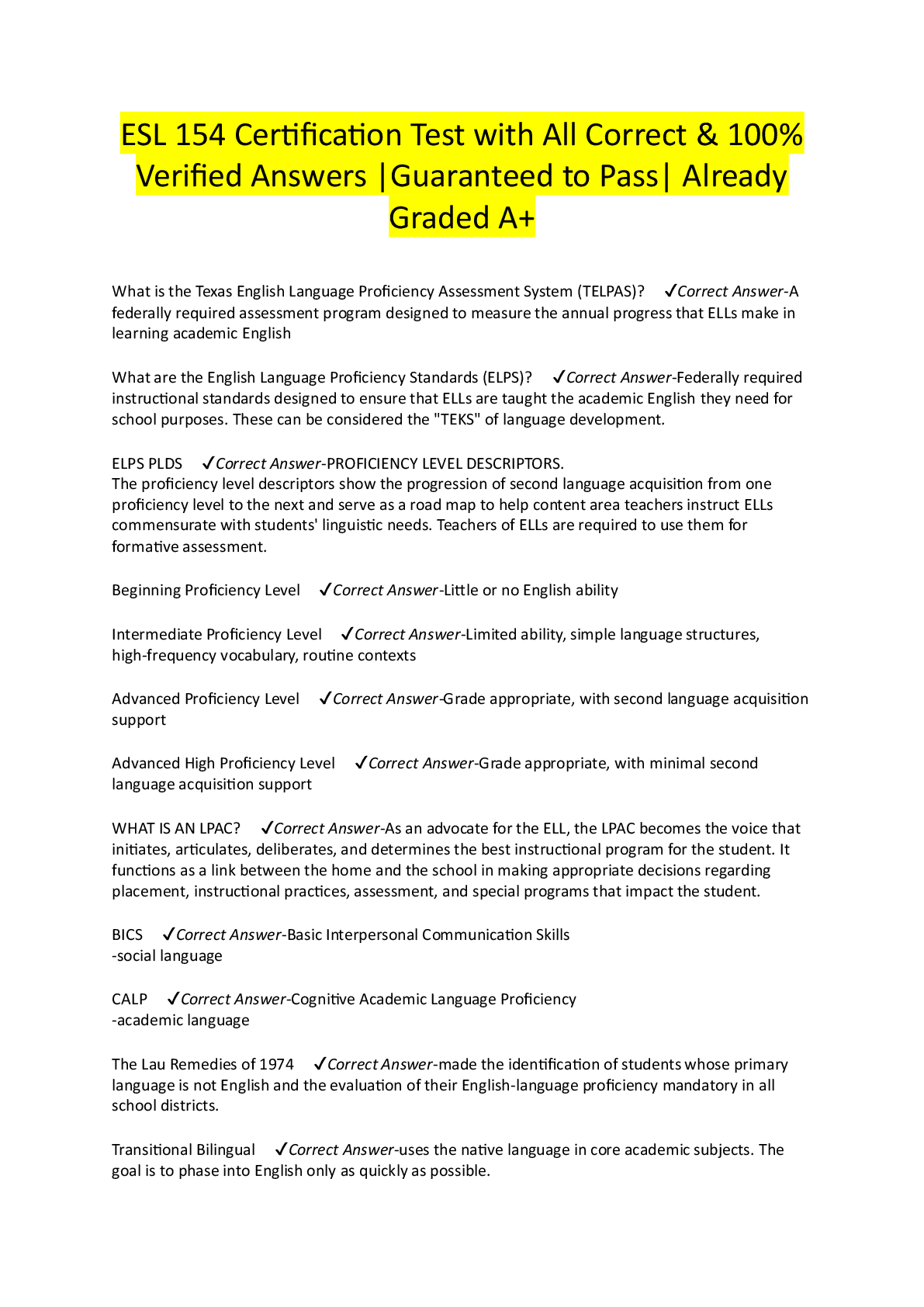*NURSING > EXAM > WALDEN UNIVERSITY - NURS 6531- FINAL EXAM STUDY GUIDE - ALSO CONTAINS Q&A WITH RATIONALE / 2021/2022 (All)
WALDEN UNIVERSITY - NURS 6531- FINAL EXAM STUDY GUIDE - ALSO CONTAINS Q&A WITH RATIONALE / 2021/2022
Document Content and Description Below
A patient who has had a swollen, nontender scrotum for one week is found to have a mass within the tunica vaginalis that transilluminates readily. The family nurse practitioner suspects: 2.) Chronic K ... idney failure: (member did not use template, no review questions received-this is all I got) Definition: The absence of kidney function. Kidney failure is also known as End Stage Kidney Disease. It is characterized by anuria and the need for renal replacement therapy or kidney transplant. 3.) Acute tubular necrosis (member did not use template, no review questions received-this is all I got) Definition: reversible or irreversible type of renal failure caused by ischemic or toxic injury to renal tubular epithelial cells. 4. Indirect inguinal hernia Definition: Indirect inguinal hernia – Indirect inguinal hernia is caused by a birth defect in the abdominal wall that is present at birth. 2. The most common type of hernia is a(n): A. indirect inguinal hernia. ** B. direct inguinal hernia. C. femoral hernia. D. umbilical hernia. . Max, age 70, is obese. He is complaining of a bulge in his groin that has been there for months. He states that it is not painful, but it is annoying. You note that the origin of swelling is above the inguinal ligament directly behind and through the external ring. You diagnose this as a(n): 5. Orchitis Definition: Orchitis is a systemic, blood-borne infection that results in an acute inflammation of one or both testicles. A 35 year old sexually active man presents with a 1 week history of fever and pain over the left scrotum. It is accompanied by frequency and dysuria. The scrotum is edematous and tender to touch. He denies flank pain, nausea, and vomiting. He reports that eh pain is lessend when he uses scrotal-support briefs. The urinalysis shows 2 + blood and a large number of leukocytes. What is the most likely diagnosis? A. Acute urinary tract infection B. Acute pyelonephritis C. Acute orthitis D. Acute epididymitis ** Orchitis is caused by which of the following? A. Mumps virus ** B. Measles virus C. Chlamydia trachomatis D. Chronic urinary tract infections that are not treated adequately A 10 year old boy complains of sudden onset of scrotal pain upon awakening that morning. He is also complaining of severe nausea and vomiting. During the physical examination, the nurse practitioner finds a tender, warm, and swollen left scrotum. The cremastic reflex is negative and the urine dipstick is negative for leukocytes, nitrites, and blood. The most likely diagnosis is: A. Acute epididymitis B. Severe salmonella infection C. Testicular torsion ** D. Acute orchitis What type of follow up should this patient receive? A. Refer to a urologist within 48 hours B. Refer him to the emergency department as soon as possible ** C. Prescribe ibuprofen (advil) 600 mg QID for pain D. Order a testicular ultrasound for further evaluation 6. Testicular torsion Definition: Testicular torsion - obstruction of blood flow to the testes because of a twisting of the arteries and veins in the spermatic cord resulting 1. A 24-year-old man presents with sudden onset of left-sided scrotal pain. He reports having intermittent unilateral testicular pain in the past but not as severe as this current episode. Confirmation of testicular torsion would include all of the following findings except: A.unilateral loss of the cremasteric reflex. B.the affected testicle held higher in the scrotum. C.testicular swelling. D.relief of pain with scrotal elevation. ** 2. In assessing a man with testicular torsion, the NP is most likely to note: A.elevated PSA level. B.white blood cells reported in urinalysis. C.left testicle most often affected. ** D.increased testicular blood flow by color-flow Doppler ultrasound. 3. Anticipated organ survival exceeds 85% with testicular decompression within how many hours of torsion? A.1 B.6 ** C.16 D.24 7. Epididymitis 1 Definition: Inflammation or infection of the epididymis. Commonly occurs in men younger than 35 yrs. of age with chlamydia as the cause. 1. Morrison exhibits extrapyramidal side effects of antipsychotic medications. Which of the following symptoms would lead you to look for another diagnosis? A. Akathisia B. Dystonia C. Parkinsonism D. Hallucinations Rationale: Hallucinations are not extrapyramidal symptoms. Extrapyramidal side effects of antipsychotic medications include akathisia (continuous restlessness and fidgeting); dystonia (involuntary muscular movements or spasms of the face, arms, legs, and neck); and parkinsonism (tremors, shuffling gait, drooling, and rigidity, all characteristic of Parkinson’ s disease). 3. In providing primary care for a patient with posttraumatic stress disorder (PTSD), you consider that all of the following are likely to be reported except: A. agoraphobia. B. feeling of detachment. C. hyperarousal. D. poor recall of the precipitating event. ** 33. Ulnar collateral ligament sprain -- (gamekeepers thumb): Definition: Caused by forced abduction and hyperextension of the metacarpophalangeal joint, as might occur when a downhill skier falls and their thumb is thrust against a planted ski pole. Presenting Symptoms: Patients complain of pain and swelling along the ulnar as aspect of the thumb joint initially. Weakness and instability may be the primary complaints of patients who present several weeks or months following the injury. 3 Differential Diagnoses: Arthritis, Carpal tunnel syndrome, de Quervain’s tendosynovitis. Pattern Recognition: Tenderness and swelling along the ulnar aspect of the thumb (MCP) joint, weakness with pinch grip. Treatment options: Ice to the thumb, immobilization with a spica splint for 6 weeks (start gentle passive ROM exercises after 3 weeks). Review questions: 1. Which of the following is usually NOT part of treatment of a sprain? A. immobilization B. applying ice to the area C. joint rest D. local corticosteroid injection Answer: D Rationale: Rest, Ice, Compression, Elevation (RICE) for sprains 2. If any limitation or any increase in range of motion occurs when assessing the musculoskeletal system, the angles of the bones should be measured by using A. Phalen ’ s test. B. skeletometry. C. the Thomas test. D. a goniometer. 3. In assessing the skeletal muscles, you turn the forearm so that the palm is up. Thia limb away from the midline of the body. Eversion is moving the sole of the foot outward at the ankle. 34. Olecranon bursitis Definition: The human body contains more than 150 bursae. These fluid filled sacs act as a cushion between tendons and bones. Review questions: 1. The most common cause of acute bursitis is: A. Inactivity B. Joint overuse C. Fibromyalgia D. Bacterial infection 2. First-line treatment options for bursitis usually include: A. corticosteroid bursal injection. B. heat to area. C. weight-bearing exercises. D. nonsteroidal anti-inflammatory drugs (NSAIDs). 3. Likely sequelae of intrabursal corticosteroid injection include: A. irreversible skin atrophy. B. infection. C. inflammatory reaction. D. soreness at the site of injection. 35. Lateral epicondylitis Definition: also known as "Tennis Elbow", is the most common overuse syndrome in the elbow. It is a tendinopathy injury Review questions: 1. Patients with lateral epicondylitis typically present with: a. electric-like pain elicited by tapping over the median nerve b. reduced joint pain c. pain that is worst with elbow flexion (elbow ROM is usually normal) d. decreased hand grip strength** the pain is worse with resisted wrist extension 2. Risk factors for lateral epicondylitis include all of the following EXCEPT: A. repetitive lifting B. playing tennis C. hammering D. gout ** 3. Up to what percentage of patients with medial epicondylitis recover without surgery? A. 35% B. 50% C. 70% D. 95% ** 4. Initial treatment of lateral epicondylitis includes all of the following EXCEPT: A. rest and activity modifications B. corticosteroid injections** C. topical or oral NSAIDS D. counterforce bracing brace centered over the back of the forearm can help relieve symptoms Review questions: 1. Carpal tunnel syndrome is inflammation of the: A) Ulnar nerve B) Radial nerve C) Brachial nerve D) 2. The Phalen test is used to evaluate for: A) Inflammation of the median nerve ** B) Rheumatoid arthritis C) Degenerative joint chang 3. Sandra, a computer programmer, has just been given a new diagnosis of carpal tunnel syndrome. Your next step is to A. refer her to a hand surgeon. B. take a more complete history. C. try neutral position wrist splinting and order an oral NSAID. ** D. order a nerve conduction study such as an electromyography (EMG). 37. Ankle Sprain Definition: The ankle joint is the most primitive joint in the body and important for walking, running, and the performance of sports. Review questions: 1. Alexander, age 18, sprained his ankle playing ice hockey. He is confused as to whether to apply heat or cold. What do you tell him? A. “ Use continuous heat for the first 12 hours, then use heat or cold to your own preference. ” B. “ Use continuous cold for the first 12 hours, then use heat or cold to your own preference. ” C. “ Apply cold for 20 minutes, then take it off for 30 – 45 minutes; repeat for the first 24 – 48 hours while awake. ” D. “ Alternate between cold and heat for 20 minutes each for the first 24 – 48 hours. ” 2. When Maxwell, age 12, slid into home plate while playing baseball, he injured his ankle. You are trying to differentiate between a sprain and a strain. You know that a sprain A. is an injury to the ligaments that attach to bones in a joint. B. is an injury to the tendons that attach to the muscles in a joint. C. is an injury resulting in extensive tears of the muscles. D. does not result in joint instability. 3. Which of the following is usually not a part of treatment of a sprain? A. Immobilization B. Applying ice to the area C. Joint rest D. Local corticosteroid injection 38. Osteomyelitis Definition: an acute or chronic bone infection with associated inflammation. It can occur as a result of hematogenous seeding Review questions: 1. Janice is recovering from osteomyelitis of her leg. She asks you for advice as to what she can do to promote healing. You tell her to: A. put weight on the affected leg more frequently to promote increased circulation, oxygenation, and nutrition to the tissues of the wound area. B. eat foods high in vitamins and calcium and increase her calorie and protein intake. C. spend time in the fresh air and expose the wound to fresh air and sunlight. D. be sure to use strict aseptic technique when changing the dressing, which should be kept wet at all times to improve wound healing. 2. Dan, age 49, developed osteomyelitis of the femur after a motorcycle accident. Which of the following statements about the clinical manifestations of osteomyelitis is correct? A. Integumentary effects include swelling, erythema, and warmth at the involved site. B. There is a low-grade fever with intermittent chills C. Musculoskeletal effects include tenderness of the entire leg. D. Cardiovascular effects include bradycardia. 39. Muscular dystrophy Definition: Group of more than 30 genetic diseases characterized by progressive weakness and degeneration of the skeletal muscles that control movement. Review Questions: 1. What is the protein lacking or absent in muscular dystrophy a. coronin b. tubulin c. dystrophin d. keratin 2. Type of muscular dystrophy that is most common in adulthood a. Becker md b. Duchenne md c. facioscapulohumeral md d. myotonic md. 3. What type of muscular dystrophy do females get? A. becker md b. Duchenne md c. myotonic md d. none . 40. Scoliosis Definition: Lateral curvature of the greater than 10 degrees frequently with rotatory component. Functional scoliosis Review Questions: 1. The following are causes of scoliosis except: a. unknown b. spinal congenital deformity c. arthritis d. herniated disc. 2. It is defined as a true deformity of the spine a. functional scoliosis b. structural scoliosis c. arthritic scoliosis d. neurofibroma scoliosis 3. Screening for females are recommended at what age? A. 5 and 12 B. 7 and 11 3. 14 and 15 d. 10 and 12. 41. Septic Arthritis Definition: infection due to bacterial invasion of the joint space. It affects the musculoskeletal system. Review questions: 1. Bouchard’s nodule is found in which of the following? A) Rheumatoid arthritis B) Degenerative joint disease C) Psoriatic arthritis D) Septic arthritis Answer: B) Degenerative joint disease 2. Podagra is associated with which of the following? A) Rheumatoid arthritis B) Gout C) Osteoarthritis D) Septic arthritis Answer: B) Gout 42. Fibromyalgia Definition: chronic, widespread noninflammatory musculoskeletal pain syndrome with multisystem manifestations. Review questions: 1. Which of the following statements is most consistent with fibromyalgia? A. It is predominantly diagnosed in African Americans. B. It affects less than 1% of the general population. ** C. It is four to seven times more common in women than in men. D. It is most often initially diagnosed in adults younger than 20 years old and older than 55 years old. 2. Fibromyalgia is more common in patients with: A. type 2 diabetes. B. rheumatoid arthritis and systemic lupus erythematosus. ** C. migraine headaches. D. chronic obstructive pulmonary disorder (COPD). 3. Which of the following is inconsistent with the clinical presentation of fibromyalgia? A. widespread body aches B. joint swelling C. fatigue ** D. cognitive changes 43. Syncope: Definition: a temporary loss of consciousness associated with an increased rate of respiration, tachycardia, pallor, Review questions: 1. Jonas, age 62, experienced a temporary loss of consciousness that was associated with an increased rate of respiration, tachycardia, pallor, perspiration, and coolness of the skin. How would you describe this? A. Lethargy B. Delirium C. Syncope** D. A fugue state 2. The Hallpike maneuver is performed to elicit A. a seizure. B. vertigo. C. syncope.** D. a headache. 3. Common signs of high-grade aortic stenosis in an individual during exercise include all of the following except: A. dyspnea. B. angina. C. seizure. D. syncope.** 44. Migraine - Migraine Headaches Definition: Migraine headache is a common headache disorder which can be disabling, It can be with or without an aura. Review questions: 1. All of the following are possible etiologies for papilledema a. Intracranial abscess b. Ruptured aneurysm c. Migraine headaches ** d. Cerebral edema 2. The following measures are used for treating various types of headache. Which is not considered to be effective therapy for migraine? a. Propanolol prophylaxis b. Resting in a quiet and darkened room c. Trimethobenzamide suppositories for nausea d. Sodium restriction to decrease water retention ** 3.Which of the following is indicated in the prophylactic treatment of migraine headache a. ibuprofen (Motrin) b. Naproxen sodium (Anaprox) c. Propanolol (Inderal) ** d. Sumatriptan (Imitrex) 4. An adult woman comes to the clinic presenting with gradual onset of throbbing headaches behind one eye worsening over several eyes is diagnosed as a. Cluster headache b. Migraine headache ** c. Trigeminal neuralgia d. Temporal arteritis 45. Tension headaches Definition: Tension headache can be primary or secondary in origin. Primary headache include Review questions: 1. In tension-type headache, which of the following statements is true? a. Photophobia is seldom reported. b. The pain is typically described as “pressing” in quality ** c. The headache is usually unilateral d. Physical activity usually makes the discomfort worse 2. A first-line prophylactic treatment option for the prevention of tension-type headache is a. Nortriptyline ** b. Verapamil c. Carbamazepine d. valproate 3. Migraine associated with muscle or neck pain, which is NOT an International Headache Society migraine diagnostic criterion, is often diagnosed as a. Sinus headache b. Cluster headache c. Increased intracranial pressure d. Tension-type headache ** 46. Subarachnoid hemorrhage Definition: Subarachnoid Hemorrhage are usually caused by a ruptured saccular aneurysm in the circle Review questions: 1. Acute cerebral hemorrhage is best identified with which of the following imaging techniques? a. transesophageal echocardiogram b. CT Scan c. Cerebral angiogram d. MR angiography 47. Glaucoma Definition: Glaucoma is a group of eye diseases traditionally characterized by elevated intraocular pressure. Review questions: 1. A 64-year-old woman presents to your clinic with a sudden right-sided headache that is worse in her right eye. She claims her vision seems blurred, and her right pupil is dilated and slow to react. The right conjunctiva is markedly injected, and the eyeball is firm. You screen her vision and find that she is 20/30 OS and 20/30 OD. She most likely has A. open-angle glaucoma. B. angle-closure glaucoma. C. herpetic conjunctivitis. D. diabetic retinopathy. 2. Sylvia has glaucoma and has started taking a medication that acts as a diuretic to reduce the intraocular pressure. Which medication is she taking? A. A carbonicanhydrase inhibitor B. A beta-adrenergic receptor blocker C. A miotic D. A mydriatic 3. Signs and symptoms of acute angle-closure glaucoma include A. painless redness of the eyes. B. loss of peripheral vision. C. translucent corneas. D. halos around lights. 48. Meningitis Definition: Meningitis is an infection/inflammation of the meninges, CSF, and ventricles. It is caused by bacterial, viral, or fungal. Review questions: 1. When evaluating the person who has bacterial meningitis, the NP expects to find CSF results of: a. low protein b. predominance of lymphocytes c. glucose at about 30% of serum levels d. low opening pressure 2. An 18-year-old college freshman is brought to the student health center with a chief complaint of a 3-day history of progressive headache and intermittent fever. On physical examination he has a positive Kernig and Brudzinski sign. The most likely diagnosis is: a. viral encephalitis b. bacterial meningitis c. acute subarachnoid hemorrhage d. epidural hematoma 49. Giant cell arteritis --Temporal Arteritis Definition: A systemic inflammatory disorder (vasculitis) of the medium and larage arteries of the body. 1. Which of the following diseases is associated with a high risk of giant cell arteritis? A. history of transiet ischemia attacks (TIA) B. Frequent migraine headaches with focal neurological findings C. Polymalgia rheumatica (PMP)** D. Systemic lupus erythematous (SLE) 2. Which of the following diagnostic tests would be most helpful in the diagnosis of this illness? A. CT scan of the brain B. Cranial nerve exam C. Sedimentation rate ** D. CBC with differential 3. Which of the following conditions is most likely? A. cluster headache B. migraine headache with aura C. migraine headache without aura D. Giant cell arteritis ** 50. Strokes Definition: brain injury that happens when the blood supply to a part of the brain is interrupted. Review questions: 1. Of the four types of strokes, which one is the most common and has a gradual onset? A. Thrombotic B. Embolic C. Lacunar D. Hemorrhagic 2. Which of the following risk factors for a stroke can be eliminated? A. Hypertension B. Carotid artery stenosis C. Smoking D. Hyperlipidemia 3. Which of the following complications is the leading cause of death shortly after a stroke? A. Septicemia B. Pneumonia C. Pulmonary embolus D. Ischemic heart disease 51. TIA -- (transient ischemic attack) or “mini-stroke” Definition: begins just like an ischemic stroke. In a TIA, the blockage is temporary and blood flow returns 1.Risk factors for transient ischemic attack (TIA) include all of the following except: A. atrial fibrillation. B. carotid artery disease. C. combined oral contraceptive use. D. pernicious anemia. 2. A TIA is characterized as an episode of reversible neurological symptoms that can last: A.1 hour. B B.6 hours. C.12 hours. D.24 hours. 3. When caring for a patient with a recent TIA, you consider that: A. long-term antiplatelet therapy is likely indicated. B. this person has a relatively low risk of future stroke. C. women present with this disorder more often than men. D. rehabilitation will be needed to minimize the effects of the resulting neurological insult. 52. Trigeminal neuralgia Definition: Pain disorder affecting the sensory branches of the trigeminal nerve (5th CN). AKA “tic Review questions: 1. A 56-year-old man complains of several episodes of severe lacerating pain that shoots up to his right cheek and is precipitated by drinking cold drinks or chewing. These episodes start suddenly and end spontaneously after a few seconds with several episodes per day. He denies any trauma, facial weakness, or difficulty swallowing. He has stopped drinking cold drinks because of the pain. Which of the following is most likely? Trigeminal neuralgia Cluster headache Acute sinusitis Sinus headache 2. Which of the following cranial nerves is evaluated when a wisp of cotton is lightly brushed against the corner of the eye? CN II CN III CN IV CN V 53. Bell’s palsy Definition: Bell’s Palsy: acute, unilateral weakness or paralysis of the facial nerve (CN Vll) in the absence 1.You examine a 29-year-old woman who has a sudden onset of right sided facial asymmetry. She is unable to close her right eyelid tightly, frown, or smile on the affected side. Her exam is otherwise unremarkable. This presentation likely represents paralysis of CN: A: lll B. lV C. Vll D. Vlll 2. Which represents the most appropriate diagnostic test for the patient in the previous question? A. CBC with WBC Differential? B. Lyme disease antibody titer? C. CT scan of the head with contrast? D. BUN and Creatine levels? Correct answer is: B 3. In prescribing prednisone for the patient with Bells palsy, the NP considers that its use: A. Has not been shown to be helpful in improving outcomes in the condition. B. Should be initiated asap after the onset of facial paralysis. C. Is likely to help minimize ocular symptoms. D. May prolong the course of the disease. 54. Epilepsy Definition: Neurologic disorder that results in recurrent unprovoked seizures lasting at least 5 minutes. They are divided into syndromes. Seizures are classified as Partial or generalized. (Excessive and Review questions: 1. Treatment options for an adult with seizures include all of the following agents EXCEPT: a. Carbamazepine b. Phenytoin c. Gabapentin d. tamsulosin Answer: D. Tamsulosin (Flomax) 2. Which of the following best describes patient presentation during tonic-clonic (grand mal) seizure? a. Blank staring lasting 3 to 50 seconds, accompanied by impaired level of consciousness b. Awake state with abnormal motor behavior lasting seconds c. Rigid extension of arms and legs, followed by sudden jerking movements with loss of consciousness d. Abrupt muscle contraction with autonomic signs 3. A patient taking phenytoin can exhibit a drug interaction when concurrently taking: a. Cyclosporine b. Famotidine c. Acetaminophen d. Aspirin 55. Parkinson’s disease Definition: Idiopathic, progressive, chronic, incurable neurodegenative movement disorder Review Questions: 1. Dopamine or dopamine agonists used to treat Parkinson disease include all of the following except: a. Levodopa b. Chlorpromazine c. Ropinirole d. Pramipexole 2. Parkinson disease is primarily caused by: a. Degradation of myeline surrounding nerve fibers b. Alterion in dopamine-containing neurons within the midbrain c. Deterioration of neurons in the brainstem d. Excessive production of acetylcholinesterase in the CSF 3. The diagnosis of Parkinson disease relies on findings of: a. Clinical evaluation of six cardinal features b. Head MRI or CT scan c. Pleocytosis in the CSF d. A visual evoked potential test Review Questions: 1. The cause of multiple sclerosis is best described as: a. A destructive process of the never fiber protecting myelin b. An intracranial viral infection c. Inflammation of the brain and/or spinal cord d. An autoimmune disorder that destroys muscle fibers 2. Common symptoms of MS include all of the following except: a. Numbness or weakness in one or more limbs b. Double vision or blurring vision c. Facial weakness or numbness d. Cold sensitivity 3. Risk factors for MS include all of the following except: a. Being older than 50 years of age b. Female gender c. Northern European ancestry d. Autoimmune disease 57. Delirium Definition: Requires prompt recognition and treatment. Often the first and only indicator in older Review questions: 1. The most common trigger for delirium is: a. alcohol withdrawal b. fecal impaction c. head trauma d. acute infection 2. Medications that commonly contribute to delirium include all of the following except: a. first generation antihistamines b. cardioselective beta-adrenergic antagonists c. opioids d. benzodiazepines 3. Which of the following electrolyte disorders is commonly associated with delirium? Hyponatremia b. hypernatremia Hyperkalemia d. hypophosphatemia Answer: A –hyponatremia – metabolic dysfunction is a common cause 4. Dave, age 76, is brought in by his wife, who states that within the past 2 days Dave has become agitated and restless, has had few lucid moments, slept very poorly last night, and can remember only recent events. Of the following differential diagnoses, which seems the most logical from this brief history? a. Depression b. Dementia c. Delirium 58. Neurofibromatosis Definition: Neurofibromatosis is a genetic disorder of the nervous system. It mainly affects how nerve Review questions: 1. Neurofibromatosis NF1 is also known as ________. It is caused by a gene mutation on chromosome 17 which encodes neurofibromin and affects around 1 in 4,000 2. What are common complications of neurofibromatosis type 1 (NF1)? 3. What is the role of urine analysis in the workup of neurofibromatosis type 1 (NF1)? 59. Alzheimer’s Disease Definition: Alzheimer’s disease (AD) is a degenerative brain disease that causes a progressive decline in neurocognitive functioning and substantially interferes with social and/or economic welfare. Abnormal Review questions: 1. Which of the following is a false statement with regard to driving and Alzheimer’s-type dementia (AD)? A. Patients with AD typically continue to drive for at least 3 years following the diagnosis. B. Those with mild-to-moderate AD have an eightfold increase in the number of accidents. C. Those at early stages of AD can continue to drive safely, though driving should be monitored regularly. D. The National Transportation Safety Board recommends surrendering the driver’s license for all individuals with an AD diagnosis. ** 2. The most common etiology of dementia is: A. vascular disease. B. Alzheimer’s disease. ** C. traumatic head injury. D. drug–drug interaction induced. 3. When discussing the use of a cholinesterase inhibitor with a 72-year-old woman with a recent diagnosis of Alzheimer’s-type dementia and her family, you report that: A. this medication will help return memory to her pre-illness baseline. B. the risk associated with the use of this medication outweighs its benefits. C. this medication will likely afford clear, although minor and time-limited, benefits. ** D. the medication should have been started earlier to help prevent any change in cognition. 4. When managing dementia, cholinesterase inhibitors offer the greatest benefit: A. for prevention of Alzheimer’s-type dementia. B. in patients with mild cognitive impairment. C. in patients with mild-to-moderate AD. ** D. in patients with severe AD. 5. An 81-year-old man who was recently diagnosed with Alzheimer’s-type dementia is accompanied by his granddaughter for an office visit. The granddaughter reports that her grandfather often acts erratically with angry outbursts that can soon be followed by a more “normal” demeanor. She reports that the grandfather recently moved in with her, and she would like for this arrangement to continue as long as possible. In counseling the granddaughter, you consider all of the following except that: A.behavioral difficulties often arise in patients with AD if their usual routine is disrupted. B.treatment with a cholinesterase inhibitor will likely improve his mental status to a point similar to his pre-dementia baseline. ** C.a home safety evaluation should be conducted, and appropriate modification performed. D.any sudden change in mental status should be reported to the healthcare provider as soon as possible. 60. Peripheral neuropathy Definition: Peripheral neuropathy occurs when nerves are damaged or destroyed and can’t send Review questions: 1. A 51-year-old factory worker has noticed progressive weakness over the past year. Examination and testing reveal a painless largely motor peripheral neuropathy. Of the following agents, the one most likely to be etiologic in this case is a. Lead b. Manganese c. Thallium d. Cyanide e. Mercury Answer: MANGANESE 2. Lead poisoning, especially in adults, produces a painless neuropathy often targeting the radial nerve 3. What are the 4 major ways that peripheral neuropathy can present itself? 4. What are the 2 major groups of medications used for Peripheral Neuropathy? 61. Hyperthyroidism Definition: Hyperthyroidism 1. The best screening test for detecting hyperthyroidism and hypothyroidism is: TSH. A TSH level is the best screening test for detecting hypothyroidism. A normal TSH rules out primary hypothyroidism in asymptomatic patients 2. A middle-aged woman is complaining of feeling anxious and irritable for several months. She reports weight loss and a fine tremor in her hands that bothers her even when she is at rest. She has lost weight without changing her usual diet or activity. The patient reports that her appetite has increased. Her menstrual cycles have become irregular. Which of the following conditions is best described? 3. 62. Cushing’s Syndrome Definition: Cushing’s syndrome results from an overexposure of tissues to corticosteroids from 1. The nurse practitioner who suspects that one of her hypertensive patient’s has Cushing’s syndrome would expect to find which of the following laboratory results? a. hyponatremia b. hypoglycemia c. elevated serum cortisol levels d. decreased urine 17-ketosteroids 2. ______ Disorder in Cushing’s is due to excessive ACTH production and ACTH dependent 3. Several conditions can cause Cushing syndrome. What is the most common cause? 4. A 46-year-old woman complains of fatigue, weakness, lethargy, decreased concentration and memory, and increased facial hair over the past 12 months. She also reports gaining over 30 pounds (13.6 kg) in the past 2 months. She has a history of asthma with repeated flares during the past 6 months requiring multiple courses of prednisone therapy. A likely diagnosis for this patient is: A. type 2 diabetes. B. Cushing’s syndrome. ** C. Cushing’s disease. D. central obesity. 5. Cushing’s syndrome results from an excess of: A. luteinizing hormone. B. follicle-stimulating hormone. C. cortisol. ** D. aldosterone. 6. A first-line approach to treating Cushing’s syndrome in a 56-year-old woman who has been taking oral corticosteroids to treat rheumatoid arthritis for the past 2 years is: A. gradually tapering corticosteroid use. ** B. referral for surgery. C. consideration of radiation therapy. D. prescribing mifepristone. 7. Untreated Cushing’s syndrome can lead to all of the following except: A. rheumatoid arthritis. ** B. hypertension. C. type 2 diabetes. D. osteoporosis. 8. Cushing’s disease is the specific type of Cushing’s syndrome that is caused by: A. long-term exposure to corticosteroids. B. a benign tumor of the adrenal gland. C. a benign pituitary tumor. ** D.an ectopic tumor that produces ACTH. 9. A first-line approach to treating Cushing’s syndrome in a 56-year-old woman who has been taking oral corticosteroids to treat rheumatoid arthritis for the past 2 years is: A. gradually tapering corticosteroid use. B. referral for surgery. C. consideration of radiation therapy. D. prescribing mifepristone. ** 63. Diabetes (no definition received-member did not provide answers) Definition: Diabetes – type 1, 2 Review questions: 1. Mrs. Allen is a 67-year-old woman with type 2 diabetes who complains of seeing flashing lights and floaters, decreased visual acuity, and metamorphopsia in her left eye. The most likely diagnosis is: open-angle glaucoma, central retinal artery occlusion anterior uveitis, retinal detachment. 2. Risk factors for POAG include all of the following except: African ancestry, type 2 diabetes mellitus. advanced age, blue eye color. 3. You see a 38-year-old African American male with hypertension who is currently being treated with thiazide-type diuretic. His current blood pressure reading is 156/94 mm Hg and he has no history of diabetes mellitus or chronic kidney disease. Following current best evidence, you consider adding which of the following medications? ACEI, angiotensin receptor blocker (ARBs), beta-adrenergic receptor antagonist, calcium channel blocker 64. Metabolic Syndrome (no definition received-member did not provide answers) Treatment options: Diet changes (increase fiber, reduce fats and carbs), lifestyle modification Review questions: 1. Which of the following is included in the National Cholesterol Education Program (NCEP) Adult Treatment Panel (ATP) III definition of metabolic syndrome? A) Elevated triglycerides (150 mg/dL or greater) B) Decreased high-density lipoprotein (HDL) (<40 mg/dL in men, <50 mg/dL in women) C) Abdominal obesity/central adiposity (waist circumference >102 cm [40 inches] in men, >88 cm [35 inches] in women) D) All of the above 2 . Which of the following is a criterion outlined by the American College of Endocrinology's definition of insulin resistance syndrome? A) HDL greater than 50 mg/dL B) Fasting glucose 80–100 mg/dL C) Triglyceride level less than 150 mg/dL D) Blood pressure greater than 130/85 mm Hg 3 . Which of the following statements regarding the epidemiology of metabolic syndrome is TRUE? A) Metabolic syndrome is roughly the same among non-Hispanic white women and men. B) Metabolic syndrome is more prevalent among non-Hispanic black men than non-Hispanic black women. C) Metabolic syndrome is more prevalent among Mexican American men than Mexican American women. D) All of the above 65. Anemias – iron deficiency Definition: Iron deficiency anemia- anemia with a decrease in serum iron level Review questions: 1. Stu, age 49, has slightly reduced hemoglobin and hematocrit readings. What is your next action after you ask him about his diet? a. Repeat the laboratory tests b. Perform a fecal occult blood test c. Start him on an iron preparation d. Start him on folic acid 2. Tina, age 2, had a complete blood count (CBC) drawn at her last visit. It indicates that she has microcytic hypochromic anemia. What should you do now at this visit? a. Obtain a lead level b. Instruct Tina’s parents to increase the amount of milk in her diet c. Start Tina on ferrous sulfate (FeoSol) and check the CBC in 6 weeks d. Recheck the CBC on this visit 3. Which is the best serum test to perform to spot an iron-deficiency anemia early before it progresses to full-blown anemia? a. Hemoglobin b. Hematocrit c. Ferritin d. Reticulocytes 66. Hemolytic Anemia Definition: Thalassemia Minor-genetic disorder in which the bone marrow produces abnormal Review questions: 1.Thalassemia is caused by a. Blood loss b. Impaired production of all blood-forming elements c. Increased destruction of red blood cells d. Autoimmune antibodies 2. Beta thalassemia minor is considered a: a. Macrocytic anemia b. Normocytic anemia c. Microcytic anemia d. Hemolytic anemia 3. What is the best diagnostic test for thalassemia? a. CBC b. MCV c. Hemoglobin electrophoresis d. Bone marrow biopsy 67. Sickle Cell Anemia Definition: Chronic hemolytic anemia that is genetically (autosomal recessive) transmitted and Review questions: 1. An 18-year-old male with a history of sickle cell anemia calls the nurse practitioner on the phone complaining that he woke up with a painful penile erection 4 hours ago. The nurse practitioner would follow which of the following treatment plans? 2. The most sensitive and specifi c diagnostic test for both sickle cell anemia and thalassemia is: 3. When advising a patient about injectable infuenza immunization, the nurse practitioner (NP) considers the following about the use of this vaccine: 68. Aplastic Anemia Definition: Aplastic anemia is a syndrome of bone marrow failure characterized by peripheral Review Questions: 1.Select treatment options for aplastic anemia A. IV equine ATG B. Bone marrow transplant ** C. Splenectomy D. Immune suppression 2. How would you diagnose aplastic anemia? A. Blood smear B. Bone marrow biopsy ** C. Spleen biopsy D. CBC E. Magic 8-ball consultation 3. Aplastic anemia can be acquired (more common) and inherited. What are some of the ways it can be acquired? (select all that apply) A. Post viral infection ** B. Pregnancy ** C. Ionizing radiation ** D. Drugs and chemicals ** E. Who knows? (idiopathic) ** Feedback: yes, all. Also: paroxysmal nocturnal hemoglobinuria. Chemotherapy drugs have a dose-response severity. The inherited disorder is called Fanconi's anemia. 4. Aside from the gradual onset signs of anemia, what other clinical presentations would you see with aplastic anemia? 1. Koilonychias, "spoon nails" 2. Associated thrombocytopenia, e.g. history of bleeding from the gums ** 3. Neutropenia, e.g. repeat bacterial infections ** 4. Purpura ** 5. Pica 69. VITAMIN DEFICIENCY ANEMIA Definition: the lack of healthy RBC due to the lack of vitamins B12, folate (B9), and vitamin C resulting in Review questions: 1. Which of the following is not associated with B12-deficiency anemia? A) Spoon-shaped nails and pica B) A red and swollen tongue (glossitis) and a vegan diet C) Macrocytes and multisegmented neutrophils D) Tingling and numbness in both feet 2. A nurse practitioner is giving dietary counseling to a 30-year-old male alcoholic who has recently been diagnosed with folic acid deficiency anemia. Which of the following foods should the nurse practitioner recommend to this patient? A) Tomatoes, oranges, and bananas B) Cheese, yogurt, and milk C) Lettuce, beef, and dairy products D) Spinach, liver, and whole wheat bread 3. Which of the following findings are seen in a patient with folate-deficiency anemia? A) Microcytic and hypochromic red blood cells B) Microcytic and normochromic red blood cells C) Normal size and color of the red blood cells D) Macrocytic and normocytic red blood cells Answer: 4. The red blood cell (RBC) peripheral smear in pernicious anemia will show: A) Microcytic and hypochromic cells B) Microcytic and normochromic cells C) Macrocytic and normochromic cells D) Macrocytic and hypochromic cells 70. Adrenal insufficiency Definition: Primary Adrenal Insufficiency, Addison Disease – adrenal glands don’t produce enough Review questions: 1. All of the following are considered target organs that are more likely to become damaged due to chronic hypertension except: A) Eyes B) Heart C) Adrenal glands D) Kidneys 2. A 34-year-old woman complains of progressive weakness, fatigue, poor appetite, and weight loss. She has also noticed the development of hyperpigmentation, mainly on the knuckles, elbows, and knees. All of the following blood tests can be used to help confirm a diagnosis of Addison’s disease except: A. sodium. B. potassium. C. cortisol. D. folate. ** 3. The hormone cortisol plays a role in all of the following processes except: A. maintaining glucose control. B. maintaining thyroid function. ** C. suppressing the immune response. D. helping the body respond to stress. 4. Which of the following is a mineralocorticoid? A. cortisol B. aldosterone ** C. insulin D. hydrocortisone 5. Secondary adrenal insufficiency can occur with the presence of a diseased or malfunctioning: A. pituitary gland.** B. thyroid. C. pancreatic beta cells. D. hypothalamus. 6. A 43-year-old man is experiencing an acute adrenal crisis and presents with prominent nausea, vomiting, and low blood pressure. He appears cyanotic and confused. The most appropriate treatment is an injection of: A. epinephrine. B. insulin. C. adrenaline. D. hydrocortisone.** 7. A 24-year-old female runner is diagnosed with Addison’s disease. In counseling her about exercise, you recommend: A. tapering her running to only 10 minutes per day for 2 to 3 days per week. B. ceasing any prolonged strenuous exercise. C. ensuring an ample amount of sodium is ingested. ** D. switching to a nonimpact exercise. 71. Pituitary Gland Disorders Definition: The pituitary gland is a tiny organ, the size of a pea, found at the base of the brain. As the Review questions: 1. Secondary adrenal insufficiency can occur with the presence of a diseased or malfunctioning: A. pituitary gland. B. thyroid. C. pancreatic beta cells. D. hypothalamus. 2. Cushing’s disease is the specific type of Cushing’s syndrome that is caused by: A. long-term exposure to corticosteroids. B. a benign tumor of the adrenal gland. C. a benign pituitary tumor. D. an ectopic tumor that produces ACTH. 3. TSH is released by the: A. thyroid follicles. B. adrenal cortex. C. hypothalamus. D. anterior lobe of the pituitary. 72. Lupus -- Lupus (Systemic Lupus Erythematosus) Definition: A chronic inflammatory rheumatic disease that affects multiple systems: joints, skin, 1. A positive ANA test is a sensitive marker for the presence of: A. hyperparathyroidism. B. systemic lupus erythematosus (SLE). ** C. Kawasaki disease. D. leukocytosis. 2. Long-term effects of SLE can include all of the following EXCEPT: A. birth defects when occurring in a pregnant female. ** B. kidney failure. C. avascular necrosis. D. pericarditis. 3. Common physical findings of SLE include all of the following EXCEPT: A. weight gain. ** B. joint pain and swelling. C. fatigue. D. facial rash. 4. All of the following diagnostic findings are expected in a patient with SLE EXCEPT: A. elevated ESR. B. anemia. C. negative ANA test. ** D. proteinuria. 5. First-line treatment of SLE in a patient with mild symptoms is: A. systemic corticosteroids. B. hydroxychloroquine plus NSAIDs. ** C. anakinra. D. methotrexate. 73. Hashimoto’s syndrome (aka chronic autoimmune thyroiditis and chronic lymphocytic thyroiditis) Definition: An autoimmune disease and most common cause of hypothyroidism in America. Difficult to Review questions: 1. Hypothyroidism most often develops as a result of: A. primary pituitary failure. B. thyroid neoplasia. C. autoimmune thyroiditis. ** D. radioactive iodine exposure 2. Which is following is the least helpful test for the assessment of thyroid disease? A. total T4 B. thyroid-stimulating hormone (TSH) C. free T4 D. thyroid peroxidase (TPO) antibodies ** 3. Periodic routine screening for hypothyroidism is indicated in the presence of which of the following clinical conditions? A. digoxin use B. male gender C. Down syndrome D. alcoholism 74. Grave’s disease Definition: Graves Disease-is an autoimmune disease in which thyroid-stimulating antibodies cause increased thyroid function; most common cause of hyperthyroidism. Review questions: 1. Physical exam findings in patients with grave’s disease include A. Muscle Tenderness B. Coarse, dry skin C. Eyelid retraction D. Delayed relaxation phase of the patellar reflex 2. The mechanism of action of radioactive iodine in the treatment of grave’s disease is to: A. destroy the overactive thyroid tissue B. Reduce production of TSH C. Alter thyroid metabolic rate D. Relieve distress caused by increased thyroid size 3. Which of the following medications is a helpful treatment option for the relief of tremor and tachycardia seen with untreated hyperthyroidism? A. Propranolol B. Diazepam C. Carbamazepine D. Verapamil 75. PCOS Definition: PCOS (Polycystic Ovarian Syndrome): is a common endocrine disorder with heterogeneous manifestations that affects up to 7% of the U.S. population Review questions: 1. In woman with PCOS who are not attempting to conceive, what is the best medical maintenance therapy to treat menstrual disorder? A. Metformin B. Combination hormonal contraceptive C. Progestins D. Leuprolide Acetate 2. What is the first-line treatment for hirsutism in Patients with PCOS who are already taking an oral contraceptive pill? A. Flutimide B. Finasteride C. Spironolactone D. Drospirenone 3. Which of the following should be the first-line treatment for overweight women with PCOS and infertility to improve ovulation and pregnancy rates? A. Clomiphene citrate B. In vitro fertilization C. Weight reduction D. Carbohydrate restriction 76. Hodgkin’s Lymphoma Definition: A cancer of the beta lymphocytes (B cells), which are a type of white blood cell that primarily makes up the lymphatic system. There are 2 types: Classic Hodgkin lymphoma (95% of cases) versus Review questions: 1. Your client, George, age 60, presents with pruritus and complains of lymphadenopathy in his neck. He also complains of night sweats and has noticed a low-grade fever. He has not lost any weight and otherwise feels well. He is widowed and has been dating a new woman recently. On physical exam, you find enlarged supraclavicular nodes. You suspect: A. Hodgkin’s lymphoma B. lung cancer C. a lingering viral infection from a bout of flu he had 6 weeks ago D. non-Hodgkin ’ s lymphoma. Answer – A. Hodgkin’s lymphoma 2. Your client, Jackson, has decreased lymphocytes. You suspect: A. bacterial infection B. viral infection C. immunodeficiency D. parasitic infections 3. One of the most common causes of involuntary weight loss is: A. pulmonary disease B. malignancy C. endocrine disturbances D. substance abuse Answer – B 77. Idiopathic thrombocytopenic purpura (ITP) Definition: A disorder characterized by an abnormal decrease in the number of platelets in the blood Review questions: 1. Marissa is going to have a splenectomy for her idiopathic thrombocytopenic purpura (ITP). Which of the following statements about this is true?: A. splenectomy produces permanent remission in 70% – 90% of people with ITP B. splenectomy is a first-line therapy C. vitamin B 12 supplementation is essential D. anticoagulant therapy is indicated postoperatively when the platelet count rises. 2. What is the initial treatment for a patient with ITP? A. immunoglobulin therapy B. treatment with steroids C. prompt splenectomy D. platelet transfusion. 3. Which of the following is not a laboratory finding in ITP? A. normal leukocytes B. normal platelet morphology C. neutropenia D. normal hematocrit. Answer – C. 78. Thrombosis Definition: formation or presence of a blood clot in a blood vessel. The vessel may be any vein or artery Review questions: 1. Due to an increased risk of blood clots, an alternative to the contraceptive ring (NuvaRing®) or patch (Ortho Evra®) is preferred in all of the following women except: A. a 42-year-old nulliparous woman with type 2 diabetes mellitus and high LDL. B. a 31-year-old woman with a history of naturally occurring multiple gestation pregnancy. C. a 28-year-old who smokes >15 cigarettes per day. D. a 33-year-old with a family history of venous thrombosis. 2. More common etiologies of acute lower-extremity atherosclerotic arterial disease include: A. arterial embolism with underlying atrial fibrillation. B. chronic venous insufficiency. C. extension of venous thrombosis. D. vessel trauma 3. At what point after childbirth can a combined oral contraceptive be started without other risk factors for venous thrombosis in a woman who is not breastfeeding? A. 1 day B. 1 week C. 3 weeks D. 6 weeks 81. Alcohol abuse disorder Definition: Alcohol withdrawal syndrome, also known as the “shakes” occurs in patients with alcohol Review questions: 1. Which of the following is not a component of the CAGE questionnaire? A. Have you ever felt you should cut down on your drinking? B. Have you been annoyed by people criticizing your drinking C. Have you ever felt guilty about your drinking? D. Have you ever engaged in a violent act while drinking? 2. During an office visit, a 38-year-old woman states, “I drink way too much but do not know what to do to stop.” According to Prochasaka’s change framework, her statement is most consistent with a person at the stage of: A. Precontemplation B. Contemplation C. Preparation D. Action 3. Lorazepam or oxazepam is the preferred benzodiazepine for treating alcohol withdrawal symptoms when there is a concomitant history of? A. Seizure disorder B. Folate deficiency anemia C. Multiple substance abuse D. Hepatic dysfunction 82. Common substance abuse: Definition: a maladaptive pattern of substance use that leads to impairment or distress. Commonly Differential diagnosis: Thyroid disorders, Delirium, Dementia secondary to HIV, syphilis, neurologic disease, alcohol abuse, Hypoglycemia, hyperglycemia, Bipolar disorder, depression, anxiety Review Questions 1. A patient to the clinic with a report of fatigue and difficulty concentrating. Which additional statement made by the patient would alert the healthcare provider to possible marijuana use? a. I feel anxious and have trouble sleeping. b. I’ve noticed that my eyes are red lately** c. I feel nauseous and don’t feel like eating d. I keep having really vivid and scary nightmares. 2. A patient is admitted to the medical unit after experiencing chest pain. Which of these additional findings would support a diagnosis of cocaine abuse? a. Jaundice b. Profuse diarrhea c. Perforated nasal septum ** d. Hypotension 3. A patient who overdose on oxycodone is given naloxone. When assessing the patient, the healthcare provider would anticipate which of these clinical manifestations of opioid withdrawal? a. Bradycardia b. Irritability and nausea ** c. Hyperthermia and euphoria d. Depressed respirations and somnolence 83 Spousal abuse: Definition: Deliberate pattern of intimidation, physical assault, emotional abuse, battery, sexual assault, economic abuse, neglect and/or other abusive behavior as part of a systematic pattern of power and Cycles of abuse: Abusive act, making up or forgetting, and Tension building Review Questions: 1. What are the cycles of violence in an unhealthy dating relationship? a. Honeymoon period and serious battering incident b. Tension phase and explosion phase c. Tension phase and honeymoon phase d. Honeymoon stage, tension phase, explosion phase ** 2. In our modern society today, what do we have now that we didn’t have before for victims of spousal abuse? a. Awareness and resources protect victims of abuse ** b. Close people like friends and family c. Relationship control d. Controlling activities 3. Nurse Angela is working in the emergency department of Nurse labs Medical Center. She is conducting an interview with a victim of spousal abuse. Which step should the nurse take first? a. Contact the appropriate legal services b. Ensure privacy for interviewing the victim away from the abuser ** c. Establish a rapport with the victim and the abuser d. Request the presence of a security guard 84. ADHD Definition: A common adult disorder, thought to be persistence of childhood attention deficit hyperactivity disorder (ADHD). Prevalence of 2% to 5% in the general population and 10% to 20% in 3 Differential Diagnosis: Depression in Adults, Bipolar in Adults, Generalized Anxiety in Adults Treatment options for ADHD without concomitant mood disorder or anxiety 1).Stimulant therapy plus psychological therapy 2) atomoxetine + psychological therapy 3) alternative experimental treatments including bupropion, antidepressants, and antipsychotic medication+ psychological therapy Review Questions: 1. Which of the following non-stimulant agents should a nurse practitioner consider for treatment of ADHD in a patient with a history of substance abuse? a. Vyvanse b. Concerta c. Atomoxetine d. Modafanil 2. Which of the following drugs that are used to treat attention deficit hyperactivity disorder is NOT classified as an amphetamine/stimulant? a. Focalin XR b. Adderall c. Ritalin d. Strattera 85. PTSD Definition: Disorder that may develop (either immediately or delayed) following exposure to a stressful 3 Differential Diagnosis: Depression, Specific Phobias , Panic Disorders Treatment options: Review Questions: (Member did not provide the answers for these questions-sorry ☹) 1. Which factors are associated with the development of post-traumatic stress disorder? a. Anxiety and low self-esteem. b. Distorted and negative cognitive functioning. c. Excess serotonin and norepinephrine levels. d. Severity of the stressor and availability of support systems. 2. When screening families for post-traumatic stress disorder following a major natural disaster, psychiatric and mental health nurses are practicing which type of disease prevention? a. Primary. b. Secondary. c. Tertiary. d. Universal. 86. Panic Disorder Definition: Characterized by recurring expected or unexpected panic attacks, worry about future attacks over a 1-month period, and changes in behavior as a consequence of the attacks. 3 Differential Diagnoses: Agoraphobia, Social Anxiety Disorder, PTSD Treatment options: reassurance ± benzodiazepines, SSRIs or SNRIs, Tricyclic Antidepressants Review questions: 1. Bob, age 49, is complaining of recurrent, intrusive dreams since returning from his Marine combat training. You suspect A. depersonalization. B. schizophrenia. C. post-traumatic stress disorder.** D. anxiety. 2. Marie, age 17, was raped when she was 13. She is now experiencing sleeping problems, flashbacks, and depression. What is your initial diagnosis? A. Depression B. Panic disorder C. Anxiety D. Post-traumatic stress disorder 3. In providing primary care for a patient with posttraumatic stress disorder (PTSD), you consider that all of the following are likely to be reported except: A. agoraphobia. B. feeling of detachment. C. hyperarousal. D. poor recall of the precipitating event. ** Review questions: 1. Morrison exhibits extrapyramidal side effects of antipsychotic medications. Which of the following symptoms would lead you to look for another diagnosis? A. Akathisia B. Dystonia C. Parkinsonism D. Hallucinations [Show More]
Last updated: 3 years ago
Preview 1 out of 90 pages
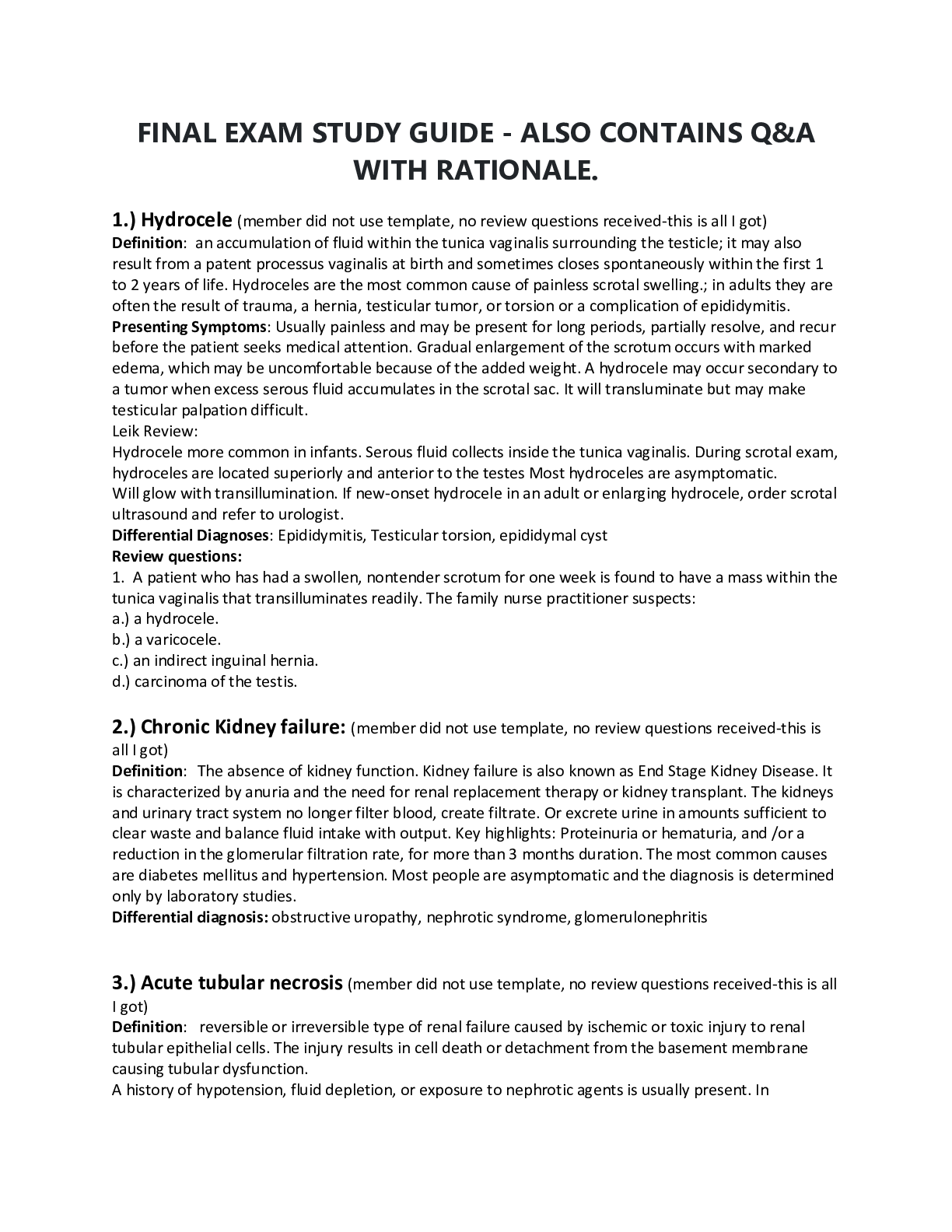
Buy this document to get the full access instantly
Instant Download Access after purchase
Buy NowInstant download
We Accept:

Reviews( 0 )
$12.50
Can't find what you want? Try our AI powered Search
Document information
Connected school, study & course
About the document
Uploaded On
Feb 04, 2021
Number of pages
90
Written in
All
Additional information
This document has been written for:
Uploaded
Feb 04, 2021
Downloads
0
Views
175

